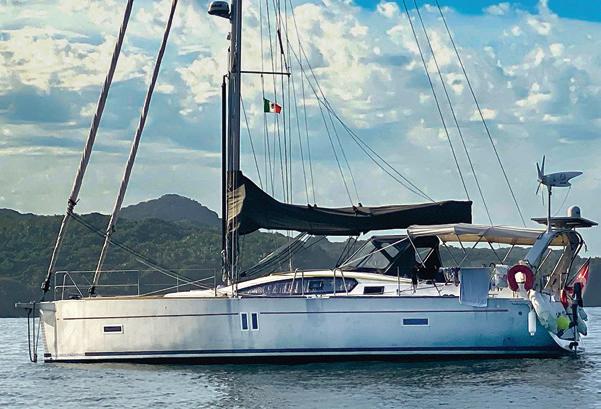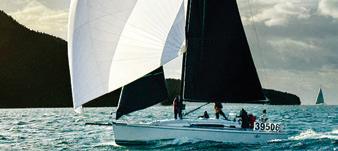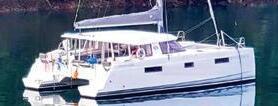


















Upgrade your running rigging with Samson Warpspeed 3 SD — a high-strength, low-stretch rope built for serious sailors. With SamsonDry™ technology, it repels water, stays light, and delivers unmatched durability in the toughest conditions. Available in spools or custom cut-to-length at Fisheries Supply.







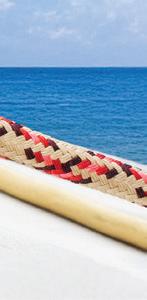



This sailor’s first boat offers fast fun with family and friends.
Schooner Martha’s main mast is now a new student-built boat.
A riveting first-hand account of survival after going overboard.

A glimpse into the fascinating arc of Marty Loken’s career.
Bateau
A new column with honest takes on cruising gear and systems.
Minding the signals that suggest it’s time for a different vessel.
Sound Series (Online!)
We do have an excellent race report, but with so much to cover with the crew overboard recovery, the more traditional race writeup by Ben Towery is over at www.48north.com.

The late winter classic lived up to its name in 2025.
CYCT Islands Race
Great wind for a new course to close out Southern Sound Series.


There’s no doubt that the biggest story in the Pacific Northwest boating community from the last month is the successful recovery of two sailors who found themselves overboard during a blustery mid-distance Center Sound Series race. The details of their 40 minutes in the water are chilling and their eventual rescue is incredible, and you can read Sheridan Ferguson’s riveting first-hand account in this issue (page 40).
I’ve had a pretty emotional response to this incident since I know both people in the water, and have sailed a whole lot of miles with one of them. With so much attention, curiosity, and engagement about the situation and rescue (thanks to a widely circulated video of the recovery), one notion seems to be sticking with me more than any other. It came from a conversation with Tolga Cezik, the skipper of the J/111 Lodos that pulled both swimmers from the water. Tolga and I reviewed his crew’s entire experience— their remarkable seamanship as well as some of their takeaways should they ever find themselves in a similar situation again. The way he wrapped up our conversation was what struck me: “I didn’t feel like we did something extraordinary, and I would like to expect all sailors out there have the same kind of attitude toward recovery and being prepared. It’s a great story, but this should be the standard.”
It almost reads as harsh, but I assure you that Tolga conveyed this response in the most empowering and vulnerable way. It is such an important reminder; one I take very much to heart. We mariners are truly dependent on one another—we are each others’ best chance of rescue. This is a central tenet in offshore sailing especially, and I can remember being a little shocked when I first learned that there’s no helicopter coming to save you once you’re more than 150 miles offshore (so for, say, 85% of a race to Hawaii, if you are rescued it will be by a boat). Tolga sailed Lodos in the 2022 Pacific Cup, and is currently preparing for this summer’s Transpac Race. He and his crew are well aware of this and are actively training to not only be fast across the Pacific, but also to be safe; for themselves, and potentially others. The immensely valuable US Sailing Safety at Sea Course is a part of the entrance requirement, and that information, expertise, and education was certainly on display in this recent recovery; and it goes hand-in-hand with the Lodos crew’s practice of these skills.
Through the years I taught sailing and ran a sailing club, I have presented the maritime Good Samaritan rule and obligation countless times. I’m not sure I ever really understood it quite like I do now. The three most recent crew overboard situations that 48° North has reported on had something in common: the individuals in the water were all rescued by a different boat than the one they fell off of. That speaks volumes about the level of skill, commitment, and awareness of our fellow mariners; but it also shines a light on how ready each of us must be, just as Tolga said and just as those who responded in this instance were.
48º North
Volume XLIV, Number 9, April 2025 (206) 789-7350
info@48north.com | www.48north.com
Publisher Northwest Maritime
Managing Editor Joe Cline joe@48north.com
Editor Andy Cross andy@48north.com
Designer Rainier Powers rainier@48north.com
Advertising Sales Ryan Carson ryan@48north.com
Classifieds classads48@48north.com
48° North is published as a project of Northwest Maritime in Port Townsend, WA – a 501(c)3 non-profit organization whose mission is to engage and educate people of all generations in traditional and contemporary maritime life, in a spirit of adventure and discovery.
Northwest Maritime Center: 431 Water St, Port Townsend, WA 98368 (360) 385-3628
48° North encourages letters, photographs, manuscripts, burgees, and bribes. Emailed manuscripts and high quality digital images are best!
We are not responsible for unsolicited materials. Articles express the author’s thoughts and may not reflect the opinions of the magazine. Reprinting in whole or part is expressly forbidden except by permission from the editor.
SUBSCRIPTION OPTIONS FOR 2025
$39/Year For The Magazine
I'll see you on the water,
Joe Cline Managing Editor, 48° North

So count me in as someone inspired-as-ever to raise my game when it comes to crew overboard recovery, and doubly dedicated to returning to the dock aboard the same boat on which I left. Personally, I don’t think I’ve been uniquely deficient or cavalier in this area of seamanship, but I would not describe myself as someone notably committed to it either. I hope I’m never in the situation my friends found themselves in last month; but if I am, I’ll be damn desperate that anyone rescuing me has been more devoted to these essential safety skills and standards than I have been—more like those who rendered remarkable aid in this scary story with a happy outcome.
$100/Year For Premium (perks!) www.48north.com/subscribe for details.
Prices vary for international or first class.
Proud members:


























48° North has been published by the nonprofit Northwest Maritime
Tl;dr: With 70-plus WA360 teams, it's possible that we’ll be responsible for an all-time low turnout at a few of your weekly beercan races this summer.
The Adventure Race Department at Northwest Maritime (NWM) has a chronic need to shake things up, and this year we’re scratching that itch with the return of WA360—the adventure race displacing R2AK for 2025 (and every odd-numbered year going forward)—shifting the spotlight squarely onto the waters in our backyard.
But still you ask: “What is WA360?” Everything. "Who is WA360?" Everybody. Every type of story, every kind of team, in every type of boat that can be made to move. It’s every kind of dream, wrapped in a hull and pointed at whatever comes next (in this case, waypoints of Olympia, Goat Island, Bellingham, and Point Roberts, bookended by beautiful Port Townsend).
In classic NWM style, we’ve pooh-poohed traditional race classes, PHRF ratings, and all that other conventional malarkey in favor of our own rules with fewer words and zero math. It’s two races, actually:
The WIND DIVISION: For those using Bernoulli’s Principle in any form, from AC70s (ok, not yet but fingers crossed) to a literal tarp on an actual kayak.
The MUSCLE GROUP: For those choosing pain, ibuprofen, blisters, and the full-body ache-reward of human-powered travel.
At the front of these two packs lives a classic battle of speed, tactics, and drive. Behind them is a broad spectrum of matchraces, grudge-matches, and hometown heroes—all hoping to cross the finish before we turn off the lights.
More than seventy teams have (so far) raised their hands to say, “Yeah. We’ll take that on.” They’re coming from every corner of Washington State (and beyond). Let’s put them in some boxes, shall we?


The R2AK Alumni: Some of your past favorites are back, trading Seymour for Deception—names you’ll recognize, such as Teams Ruf Duck, Narrows Minded, Perseverance, and Monkey Fist. Others have come together from past R2AK runs to form supergroups, including Team Toad’s Wild Ride, borne of the combination of four different R2AK efforts and aiming to claim the World Championship Belt.
The R2AK Not-Yets: Getting past the guardians of R2AK (the shadowy Vetting Team) can be tough. More than a few aspirants have fallen flat when populating their resumes for a greenlight north. Quick bad math tells us that 50% of WA360 teams are here as a test run and a CVpadding exercise for a future push to Ketchikan.
SEVENTY48 Graduates: After proving themselves in one of the most hardcore human-powered sprints anywhere, numerous Seventy48 competitors are doubling down and want more.
The Hometown Heroes: Washington’s waters have raised some of the toughest sailors and paddlers out there. They’re coming out to represent, with homeports of Olympia, Bellingham, Bothel, Cle Elum, Seattle, Everett, Shoreline, Oak Harbor, Friday Harbor, Gig Harbor, Sequim, Indianola, Port Ludlow, Anacortes, SedroWoolley, Vashon, Yelm, Tacoma, and even some folks from the saltier parts of Spokane.
Others of Note: WA360 2025 has Goliaths and Davids—from a seven-person clown-car sailing a Flying Tiger 10 to 25 separate solo teams who, for reasons only they can explain, have decided to take on 360 miles alone. There are teams racing wooden boats who believe beautiful is just as important as fast, with vessel choices like a 19-foot cedar faering with a balanced lug rig and a Drascombe Scaffie. Some teams are bringing more than just themselves to


the water—Team Guardian Sailing, fresh off a 2024 R2AK finish, is racing to support veterans overcoming trauma and PTSD through sailing.
Like everything we do at NWM, WA360 is about breathing the salt spray and engaging with the waterways just outside our windows. You don’t have to race to be part of it. Follow along. Throw a bag of candy to a passing team. Cheer from shore. Bring your boat out to bang cowbells near the waypoints. We’ll be delivering stories straight from the water—from scrappy live updates to high-polish videos. What's next? Sign up by May 1. Follow the race. Volunteer. Witness the chaos beginning June 28. Join our email list. Click some clickables on social media. Check out more: WA360.org
-Race Boss, Jesse Wiegel



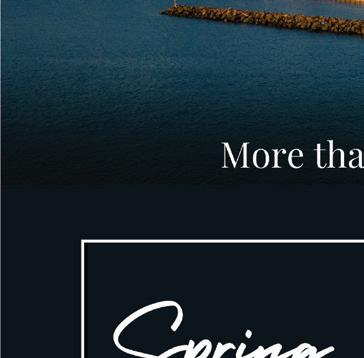















Hey Joe,
Long time reader here. I was all set to write to you, but just opened the March issue and Andy beat me to it! Well, anyways, here's what I wrote in my head...
In February, I was on my annual warm weather sailing charter, laying on one of two mooring balls in Salt Pond, St. John, USVI aboard our chartered catamaran. Mid-morning, a 40-foot monohull grabbed the ball behind us. My crew of non-sailors observed that it didn't look like all the other charter boats around and started asking questions. The gear on deck, the rig, the two boys energetically cannonballing off the bow without fear. To my eyes the boat and crew were long term cruisers and conversation flowed around what it would be like.
Something was familiar about the boat to me. The size, the blue stripe down the cabin top. As it swung in the breeze I saw the name on the hull. Started with a Y...."Hand me the binoculars...." Sure enough, it was Yahtzee. I felt like I knew the boat and crew personally after reading Andy Cross's tales over many years in 48° North and elsewhere. His stories have been an inspiration and fountain of learning, particularly as a family afloat since I have three kids around the same ages as well. Now to be sharing an anchorage.
I dinghied over and, sure enough, there was Andy, Jill, Magnus, and Porter. I felt a bit awkward knowing so much about them and in return being this anonymous face just popping by.
That afternoon, Andy graciously joined us for drinks, shared stories, and regaled my crew with the life of liveaboard cruising.
What an unexpected experience out in the wild blue yonder, and a magical reminder that our world isn't that big after all.
Hans Schumacher SV Pleiades Everett, WA

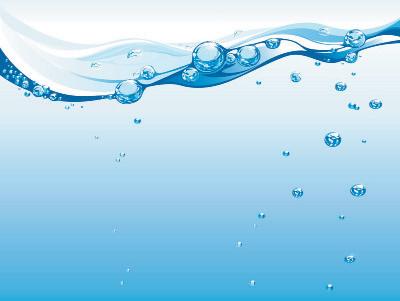

In Response to Lauren Upham’s “Still So Worth It” in the February Issue
An impressive cruise!
Larry Schultz
The Pacific Northwest’s largest spring boat show arrives in South Lake Union, April 25 – 27. The 2025 Spring Boats Afloat Show will be bigger than ever when it returns to Seattle’s Lake Union for three days at the end of April. The expanded show includes added moorage at the adjacent HC Henry Pier to accommodate up to 40 more power and sailboats.
The Spring Boats Afloat Show spotlights luxury and boating fun with on-the-water displays of power and sailing craft. Encompassing distinctive designs, elegance and performance, it’s an opportunity to explore some of the region’s largest motor yachts, impressive sailboat offerings, luxury cruising/ fishing models, high-end cruisers ideal for Pacific Northwest waters, power and sail catamarans, and much more.
“We’re excited to add the moorage space the HC Henry Pier provides, allowing us to showcase an even greater variety of boats and price ranges—there’s something for everyone,”
states Paul Groesbeck, President of the Northwest Yacht Brokers Association.
Quality shoreside exhibitors spotlight innovations in boating technology, accessories and marine services. There is plenty to see and do with boating lifestyle seminars, daily entertainment and tasty food and beverage choices.
New hours for the Spring Boats Afloat Show are: Friday 10 a.m. to 6 p.m., Saturday, 10 a.m. to 6 p.m., Sunday 10 a.m. to 5 p.m.. Through April 10, discounted “Early Bird” adult tickets (18 and over) are available for online purchase at » boatsafloatshow.com: $15 (single day) or $32 (multi-day). Discounted tickets purchased online April 11 through April 27 are adults $20, and teens (13-17), $5. Regular admission at the gate during the show is $24 for adults and $7 for teens. Children 12 and under are admitted free.
If you’re an owner, tactician, crew member, race official, or just curious, come join CYC Seattle, Seattle YC, and Sloop Tavern YC for an informative evening with ORC pro, Dobbs Davis, at CYC on April 11 at 6 p.m. Davis will dive into why ORC is the fastest-growing measurement-based handicap system in the U.S. and the largest of its kind around the world of big boat racing. It's also a unique opportunity to clarify any uncertainties as ORC gains more popularity in the Pacific Northwest.
The topic’s relevance has never been greater, with racing participants and fans surely noticing some changes to the class breaks and results in recent years. The ORC system has absolutely taken off in the Pacific Northwest, and its draw is only increasing. In spite of the obvious interest and excitement with ORC, there are complexities that differentiate it from other handicapping rules. The boats and sailors who have been cutting the trail with ORC racing in our region have discovered that not only is there a learning curve, but there have been some difficult-to-resolve questions.
Dobbs is U.S. Communications Manager for ORC and will discuss the key features of this system that produces the fairest possible handicap racing. The presentation will begin with an overview of the ORC system and will then go deeper into several areas including: measurement, ratings, scoring options, best practices, and race management. A Q&A session will follow. All are welcome, light food provided, and a cash bar will be open. » www.cycseattle.org
Jonathan McKee, owner of Riptide 44 Dark Star, is organizing a gathering to celebrate Bieker Boats. It will take place on April 27, 2025, the Sunday following Seattle Yacht Club’s Protection Island Race. Anyone who owns a Bieker boat is encouraged to come and to bring their boats. Anyone who is connected to a Riptide and members of the sailing public who are interested in the boats are also invited to join the fun. The vision is a raft up at the north end of Shilshole from 2-4 p.m., followed by a reception at Corinthian Yacht Club of Seattle.
The Northwest Marine Trade Association (NMTA) and Anacortes Chamber of Commerce are once again teaming up for the Anacortes Boat & Yacht Show and Trawlerfest, May 15 - 17, 2025 in Anacortes, WA.
The event will feature in-water and onland displays with hundreds of boats at Cap Sante Marina and neighboring boatyards, plus the return of Trawlerfest’s highly regarded 25+ seminars and educational classes that will take place May 13–17 at the nearby walkable location of Seafarers’ Memorial Park. The show will also feature shoreside displays including trailerable boats, marine accessories, electronics, destinations, and service providers.
» www.anacortesboatandyachtshow.com
KORU EXPEDITIONS NAMED NEWEST ASA AFFILIATE SAILING SCHOOL ON THE WEST COAST
Koru Expeditions is excited to announce their recently minted ASA School Accreditation. Homeported in Gig Harbor, WA, Koru Expeditions offers private and smallgroup instruction with a hands-on, expeditionstyle approach. Specializing in advanced ASA courses (103, 104, 105, 106, 107, 108 and 114), training takes place primarily aboard Koru, a 50-foot Soubise Plaisance performance catamaran. For those newer to sailing, Koru Expeditions also provides instruction on a Jeanneau Sun Odyssey 349 monohull. All programs emphasize seamanship, navigation, and offshore skills, preparing sailors for realworld cruising adventures in addition to fully meeting all ASA requirements.
» www.koru.world
Following their motto of “Leave your disability at the dock,” Footloose Disabled Sailing has recently announced their schedule for the 2025 sailing season.
With the surrounding large lakes and waters of Puget Sound, Seattle offers some of the country’s best sailing opportunities for people of all ages and skill levels. However, some members of our potential sailing population are disabled in different ways, and feel that sailing is not available for them. Enter Footloose Sailing Association, a sailing organization serving people of all disabilities since 1991.
Footloose introduces sailing as recreation and sport to disabled people of all ages. They provide safe, accessible, and rewarding sailing experiences to their disabled members along with their attending friends, families, and caregivers. Composed of over 200 participants and volunteers, Footloose brings competence in the recreational sport of sailing to the physically and mentally disabled. Footloose is a 100% volunteer operated 501 C-3 nonprofit, and a chapter of Move United, an affiliate of the US Olympic and Paralympic Committee. They operate on generous donations of time, expertise, equipment, and money—100% of all donations go directly to moorage, insurance, equipment, and operations.
Footloose operates from the North Leschi docks on the west side of Lake Washington. They sail three sloops, two specially


commissioned Martin sailboats, and four Access dinghies. The docks at Leschi Marina North have been rebuilt to improve access to wheelchairs, and a dock mounted davit system is used to safely transfer sailors from their wheelchairs to the boat. Experienced volunteers work with attending family, friends, and caregivers during the boarding process. The goal is to get three sloops, and up to six dinghies out on the water twice each sail day during the summer months.
Footloose Sailing events are scheduled on the average of twice a month throughout the late spring, summer, and early fall, and once every summer they sail across Puget Sound for a two night camping trip at Blake Island.
Footloose Sailing Schedule
• Fleet Assembly and Setup, No Sailing: April 26.
• Daysails: May 3, 17, 31; June 14, 28; July 12; August 9, 23; September 6, 20.
• Blake Island Camping Trip: July 27, 28, 29.
• Fleet Disassembly and Shut Down, No sailing: October 4
Footloose Sailing Association is an all-volunteer organization and is always looking for help with shoreside tasks, on the docks, and out on the water. It’s good, safe family fun!

For more information visit: » www.footloosedisabledsailing.org or at » www.facebook.com/FootlooseSailingAssociation
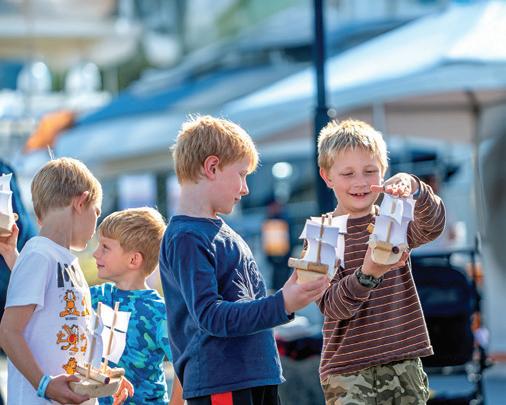
by Bryan Henry
The oceans cover 71 percent of the Earth and contain 97 percent of its water.
Water in an ocean wave doesn’t move forward—it moves up and down.
The surface layers of the oceans absorb more than half of the solar energy that reaches Earth.
The Arctic Ocean is the smallest and least explored ocean.
The Indian Ocean is geologically our youngest ocean.
The Atlantic is the second youngest of the oceans, thought to have formed about 130 million years ago.
The Atlantic Ocean is widening by about an inch each year, while the Pacific Ocean is shrinking.
1 Weight in the
Cable or rod that supports the mast sidewise
Top grades 18 Back of the boat
19 Position arrived at when the wheel is turned as far as possible, 2 words 22 Boat weight
24 On the Baltic, for example
27 Line tied to the bow of a small boat for the purpose of securing it to a dock or to the shore
29 Life ____: it keeps a swimmer
1 Cable that runs from the top of the mast to the stern of the yacht
2 Gently hit the shore, as a wave
3 Type of compass used to establish position
4 Be rife (with)
5 Prepare to get the boat sailing again (when held stationary) - 2 words
6 San ____- west coast port
7 Ancient people who used galleys as their sea transports
13 Upgrades often made in dry dock
15 Water propulsion instrument
16 Two-masted vessel
20 Loosens or lets out
21 Mistakes
23 Almond, for one 25 Rigging support 26 Concluded 28 Brazilian city 30 Sea eagle 31 Put to the test
The Pacific Ocean is the most biologically diverse of our oceans.
Africa’s Mediterranean coast lies only 8 miles south of Spain across the Strait of Gibraltar.
The Pacific Ocean is large enough to cover all seven continents.
Of the 10 deepest spots in the oceans, 8 of them are located in the Pacific Ocean.
The Pacific has more seamounts (underwater volcanoes) than any other ocean.
An unnamed mountain lying in the Pacific Ocean in a trench between Samoa and New Zealand is the world’s tallest completely submerged mountain. It’s 28,500 feet high, but its peak is 1,200 feet short of the surface.
More than 60 percent of the world’s oceans are beyond national jurisdiction.
Rivals fight over water. The word comes from Latin rivalis, living near the same river or stream, hence a competitor for the same water, fish, and game.
The doldrums are the name used for the part of an ocean near the equator where winds are calm or dull. The dol comes from Old English dol, meaning dull. Doldrums is always preceded by the word “the”. Even though plural in form, it is used with a singular verb.









Mustang Survival’s trusted dry suits, the Hudson and Helix CCS, have been upgraded with refined features to further meet the demands of the bold cold-water adventurer. Built on decades of expertise in engineering dry suits for professionals, these suits deliver superior warmth, waterproofness, and performance—whether on or in the water. Notable features include external removable kneepads and the exclusive Closed Comfort System (CCS) which allows one-handed venting and sealing to regulate temperature efficiently. Trimmable neoprene wrist seals offer a tailored fit, while the waterproof and durable 3-layer Marine Spec BP fabric provides abrasion, saltwater, and UV resistance. Made in Canada with exceptional craftmanship, every single dry suit undergoes rigorous leak-proof testing to meet the highest safety and performance standards.
Price: $1249.99 » www.mustangsurvival.com


If you’re looking to keep your bilge dry and your cabin odor-free, Bilge-Be-Dry by Neptunian Sky might be the answer for your boat. Due to size and placement, traditional bilge pumps cannot remove the last few inches of excess water that accumulates in your bilge. That’s where Bilge-Be-Dry excels. The low-profile bilge water pickups remove the last drops of water in the lowest parts of your bilge or in hard-to-reach compartments. When the pump is running, twenty small holes along the bottom of the pickup provide a debris barrier to suck up water. Bilge-Be-Dry connects to your phone or tablet through a free app that allows you to customize operation with two options: Run the “Timer” option up to 20 minutes after boating in heavy seas or upon washdown. Or, choose the “Schedule” option for five customizable run times during the day. If you choose not to use the app, the pump is configured to automatically cycle five times per day for two minutes each time. Bilge-BeDry is available in four 12v DC pump configurations: Single pump, Dual pump, Triple pump, and Quad pump.
Price: $369.99 » www.neptunianskyllc.com



If there is one piece of gear that cruisers can’t live without, it’s a good gear bag to haul tools and boat parts, groceries, clothes and laundry, and more. Grundens 50L Gear Hauler Tote is designed to carry your stuff on day trips, long weekends, and full-on expeditions. Built to be durable, rugged, and functional, the bag can handle dirty, wet, grimy gear, yet it also features a dry section to keep electronics and other valuables safe. Water-resistant construction and a double-side coated Shoreman fabric keeps moisture out, and an external storage pocket and one zip interior pocket can hold smaller items. The bag also has long Grundens logo embossed webbing handles and external tie down anchor points. Two colors are available to choose from: dark gray and orange.
Price: $99.99 » www.grundens.com




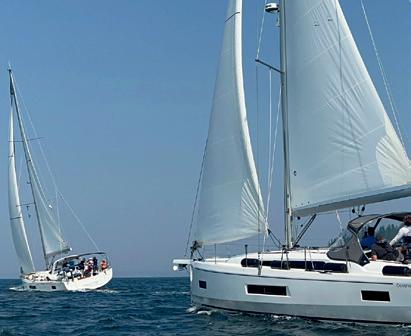










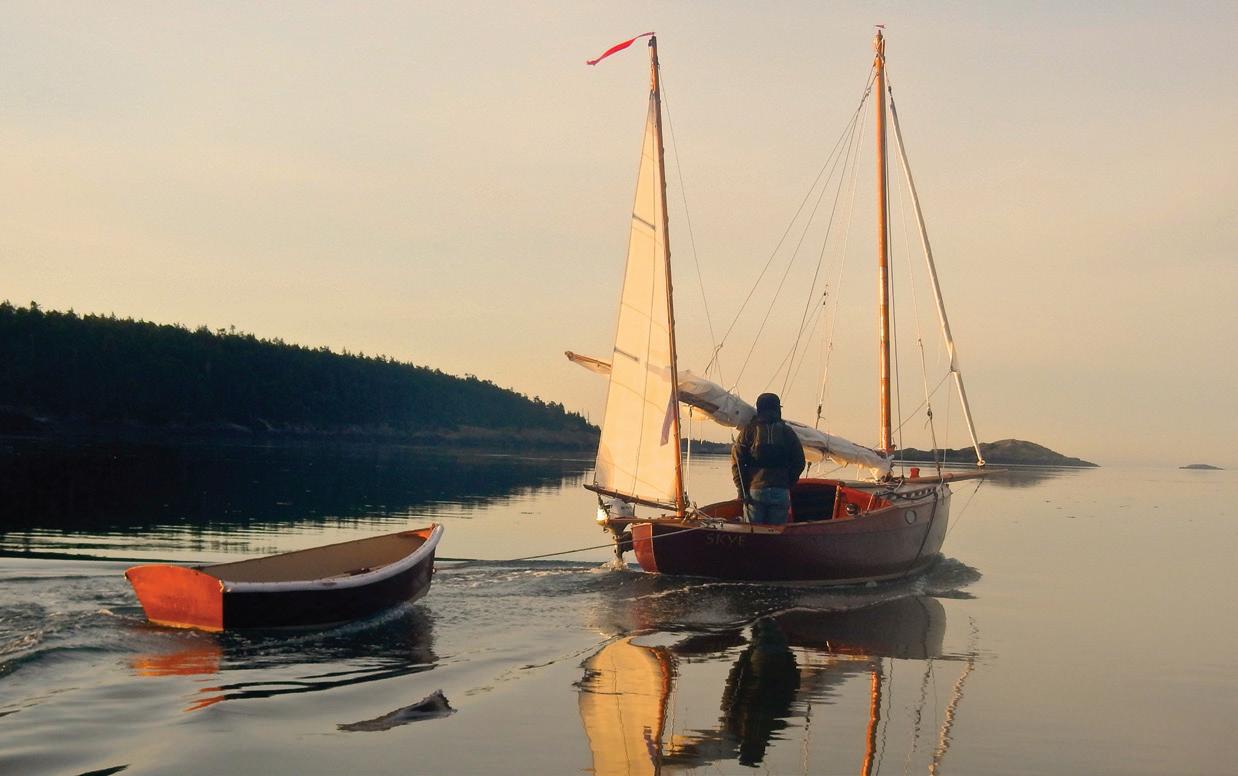
by Bruce Bateau
Marty Loken may be an octogenarian, but it’s hard to keep up with the small craft maven. Among his many endeavors that have buoyed the Pacific Northwest boating community are running a bevy of boating events, writing for Small Craft Advisor magazine, and being an active member of the Port Townsend Pocket Yachters.
Recently, I phoned Marty for details about the upcoming second Pacific Northwest Small Boat Festival on May 30-31, 2025, at Port Ludlow Marina. What I assumed would be a 30-minute call turned into a joyfully rambling twohour conversation about Marty’s past and future in boats. We only ceased when I realized that it was my bedtime, and that we hadn’t even talked about the event itself. This seemed completely appropriate, given how sailors think: tides and winds wait for no man, but being present for a good yarn is a big part of the fun of hanging out with other boaters.
My follow-up call reached Marty aboard Raven, his 30-foot, 1930 John Alden motor cruiser, which he lived on for nearly three years. These days, he’s stationed ashore on Bainbridge Island, but has been camping out on Raven at Port Ludlow Marina between work sessions on his latest passion, a 20-foot trailerable “dreamboat” cabin cruiser that will have a tiny galley, a motor, pilothouse, and cuddy cabin for two. As he notes in one of his recent columns, “I know I’m damned lucky, and only semi-

delusional when I say this: I’m still aging into boats, not out of boats. It feels like I’m slipping back to where it all started as a kid, in the smallest of boats.”
When Marty references his childhood, he describes a state of mind, as well as a physical place. His family ran Loken Lumber Specialties, a mill in Ballard, where he was “swimming in cedar.” In his family, “You didn’t buy much—you built it.” At age ten, he asked his father to build him a boat in their basement workshop. Marty’s dad pointed him towards the



tools and told him, “You can figure it out.”
Despite the lack of instruction, Marty figured out enough to make three boats, one of which he sold to a neighbor. By the time he was a teenager, he was interested in restoration and started hanging out with “water rats,” who clearly had an impact on him. “Like all teenagers, I wanted to go fast,” Marty recalled. He started playing with hydroplanes, water skiing, and racing boats.
Marty dreamed of building boats as a career after high school, but concluded at that age that “it was a stupid idea.” His mother was a poet and his first editor. She nurtured another of his interests, writing. After working at his high school newspaper, he won a job at the Seattle Times as a copy boy, where he completed tasks around the newsroom. Eventually, he landed a job there as a cub reporter, writing stories on topics ranging from the Black Panthers to nesting birds on skyscrapers. An appreciation for working with photographers led him to a publishing job in Alaska. After becoming disillusioned with journalism, he shifted to photo licensing for the next 20 years. During this time he was always restoring or building boats, which allowed him to explore up and down the Inside Passage and the Salish Sea.
Marty eventually found his way back to Seattle, where he purchased the Wooden Boat Shop, a storefront near Lake Union that offered classes and sold supplies and tools. Despite Marty’s passion for boats, it didn’t turn out to be a viable business. That didn’t keep Marty away from boat work though. Soon he was organizing five boatrights at a restoration business that specialized in vintage launches, like


Hacker Craft, Century, and Chris Crafts. There, he stayed busy coordinating a dozen projects at a time.
The pressure of contending with demanding customers made him wish he was working peacefully in his garage; so he moved farther from Seattle, eventually renting work space from his friend George Calkins, the designer of the legendary Bartender boats. During this venture he repaired and restored small wooden rowing and sailing boats, but he started getting interested in 1950s era trailerable powerboats from the early days of fiberglass production. He lovingly described their wraparound windows, sound hulls, and classically inspired interiors that were in need of love. “We had a great time,” he told me, “until we ran out of boats to restore.”
A persistent theme emerges in conversations with Marty: boats are interesting and rewarding. He’s not picky about the material, but he gets excited about the style, what the boat can do, and where it can take you. Although he’s had plenty of adventures on his own, he seems most pleased when his passions involve other people, which make them more fun.
For a few years, Marty organized the Pocket Yacht Palooza, a land-based display of small boats. This was followed by the associated “Crooza,” in which a subset of participants went campcruising for a few days afterwards. When these gatherings ended, Marty started dreaming of a new event to bring small boat sailors together—and in 2019, the Salish 100 was born. The event brought together dozens of sailors of small craft for a five-day cruise from Olympia to Port Townsend. Marty did much of the organizing himself, spending a modest $380 for a Coast Guard marine events permit. “Looking back, I realize I’m an event organizer,” he said. “I love helping people get on the water and learn something about small boat cruising. And learning from each other.”
In 2024, along with some friends, Marty launched his newest project, the Pacific Northwest Small Boat Festival. During the event, which took place at the Port Ludlow Marina, 75 sail, power, or human-powered craft were displayed, many in guest slips, while others could

be viewed on the grounds.
I shouldn’t have been surprised to learn that only one presentation took place; an experiment in electric propulsion led by participants. The festival is “a gab fest,” Marty explained, where people learn from each other. “You just set boat nerds free; you don’t have to do anything.”
This outlook is in keeping with Marty’s belief that the small craft community has a culture of teaching, learning, and free sharing of information. Last year’s event had a mix of boats from Washington, Oregon, British Columbia, and a few inland states, with regulars from past events and about a third of the attendees there for the first time.
To Marty, whatever kind of boat he currently owns is always the best one, because it captures his attention, allowing him to be creative, to dream, and to have fun with friends. If that mindset resonates, consider attending this year’s festival.
(The Northwest Small Boat Festival is open to trailerable craft under 25 feet and will begin the evening of Friday, May 30. Pre-registration to display a boat is required, but participation at the Port Ludlow Marina on the Saturday of is free. For more information, visit www.pocketyachters.com/events/sbf/ )
Bruce Bateau sails and rows traditional boats with a modern twist in Portland, Oregon. His stories and adventures can be found at www.terrapintales.wordpress.com




By Gio and Julie Cappelli
Welcome to the first installment of Necessary or Nice, a new column where we tackle the age-old question for cruisers and sailors alike: Is a particular “thing” truly essential for cruising, or is it a nicety that makes life on the water a little sweeter?
If you’ve been cruising for any amount of time, you already know about the thin line between necessity and indulgence when it comes to boat gear. While it’s tempting to imagine having unlimited time and money to outfit your boat with the latest, greatest, and most innovative equipment, the reality of cruising requires a more practical approach for almost everybody. It’s all about prioritizing what you need versus what’s nice to have for an added touch of comfort or convenience.
Certainly, there’s room for varying perspectives in this realm, and this column will feature our informed opinions that may or may not align with yours. Still, we hope you’ll find our takes rooted in knowledge and experience.
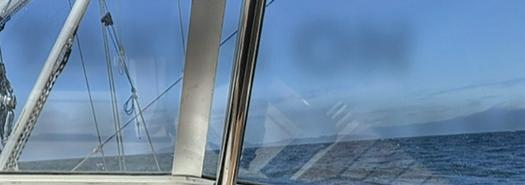

Who are “we” behind these opinions?
We’re Gio and Julie of Pelagic Blue, our sail training outfit through which we lead cruising expeditions far afield from our homeport in Anacortes, Washington. In 2021 we took a “seabattical” from our careers as fisheries biologists to go cruising, got hooked, and decided not to return to land life as we knew it. But before we set sail across the Pacific Ocean, we did something unconventional, we went back to school.
After reading countless stories of cruisers plagued by outrageous boat maintenance bills and nightmare refits, we realized that a solid education in all things boat could only help us. Nine months later, we graduated as 4.0 students and certified ABYC and NMEA marine technicians. We then spent a few years working in the industry and became capable of diagnosing and repairing just about everything on a modern cruising boat (which is major progress, because before that, Julie was convinced electricity was out to get her).
Shortly after graduation, we bought a 2002 Malö 39, Sea Fox, in San Diego.
Strong, capable, and ready for bluewater cruising, we spent five months correcting her most critical deficiencies before setting sail for Mexico, Hawai’i, Alaska, and British Columbia. And the best part? We completely relished our first year of cruising. We had fun, learned a ton, and grew closer as co-captains—a far cry from the cruisers we met who were bogged down by endless maintenance problems, unbalanced crew training, missed weather windows, and overbudget refits.
Over 40,000 miles of sailing have taught us so much, including the fact that not all gear is created equal. The boating world is full of products that sound perfect in theory but may not hold up to the practical demands of life afloat. Likewise, there are those less glamorous yet incredibly useful tools and solutions that often go unnoticed but make all the difference when you’re braving the elements or tackling a challenging project. That’s where Necessary or Nice comes in. Each mariner will have specific needs and wants, but we hope and believe that opinions based on real life education



and experience are valuable, even when their content may not be universal for all of our fellow boaters. In this column, we’ll share our honest, sometimes spicy, takes on various cruising boat systems and components. Our goal is to help you make informed decisions about what is truly essential or just nice to have as you gear up for your next cruising adventure. So, without further ado… the first topic is: Full Cockpit Enclosures.
For year-round Pacific Northwest cruisers, a full cockpit enclosure might be the best money you’ll ever spend on your boat. The benefits are clear, especially if you’re planning to venture into Southeast Alaska, where the state bird is widely recognized as the mosquito. A full cockpit enclosure provides an all-weather “back porch” for those with limited space below deck. And with a good heater, it creates a warm, dry outdoor living space to watch whales or wave to the neighbors—even in the harshest weather. It also provides an excellent opportunity to increase your solar capacity for off-grid adventures, with the added benefit that the canvas behind the boom is unlikely to be shaded. Most enclosures feature multiple windows, typically made of acrylic, polycarbonate, or vinyl. Tuffak polycarbonate, used by top-tier canvas manufacturers, offers excellent visibility

but comes with trade-offs: it’s more vulnerable to UV and physical damage and, like all premium products, it carries a higher price tag. Consistent with a premium cost is the need for a modular design to facilitate maximum versatility. Every design feature should be intentional and deliberate, and include removable protective covers to prolong the life of each window. One common challenge with removable panels is storage; haphazardly tossing them into a lazarette will lead to scratches in no time. If not properly protected, the marine plastics used for these windows can degrade over time, resulting in yellowing and reduced visibility. The best solution? Snap-on window covers, which a skilled designer can integrate into the enclosure to protect the windows when not in use, are a great feature. We use them aboard Sea Fox and couldn’t be happier with their performance. But don’t be lazy—we make sure to pull them out every time we anchor, even if we only expect to be there briefly. You never know what the weather will throw your way, or who might drop
anchor next to you and encourage you to stay a little longer.
A recent client of ours shared a quote from a reputable marine canvas company for fully enclosing the cockpit of a 34foot sailboat, including a new dodger. The total came in at over $18,000. Complicating the sense of “investment” with this expensive installation, enclosures do have a limited lifespan— which, of course, is always the case with boat gear. The durability of your marine canvas depends on both the material quality and how well you maintain it. With proper care, high-quality canvas can last 7 to 12 years. While a full enclosure might initially feel like a luxury, the longterm benefits—especially in terms of added living space, comfort, and utility— can make it a solid investment for those planning to spend extended time aboard, particularly in winter.

When evaluating your enclosure’s design, consider the configuration of your stern pulpit and any accessories attached to it. Items like your outboard, grill, stern tie reel, dinghy davits, or even a downrigger (if you’re a salmon fanatic) will need to be factored into the design. The enclosure will need to accommodate these accessories or be scaled down so it does not extend that far aft. Additionally, the canvas must be securely attached to the boat. While canvas anchors come in various shapes and sizes, they all require many small holes to be drilled into your boat’s hull (which, spoiler alert, we don’t love). Once drilled, it’s essential to seal the fasteners with a quality, nonpermanent adhesive sealant to prevent water ingress.
While enclosures offer valuable protection from the elements, they come with trade-offs, particularly when it comes to sail handling and visibility. For some, staying dry and warm in tough conditions justifies the investment. But for others—especially those who prefer a traditional sailing experience or sail
in milder weather—the added cost and potential complications may not be worth it. It all depends on your sailing style and whether you value shelter over the freedom to fully engage with the elements.
Let’s not forget, we are sailors, and part of that identity is our relationship with the floppy white things attached to our masts. It’s critical for safety that we maintain clear visibility of our sails while underway. This brings us to one of the biggest drawbacks of a full enclosure: staying connected to the outside world while sailing. When cruising the Salish Sea and west coast of Vancouver Island, we keep a vigilant bow watch at all times to look out for logs, debris, and other hazards, as well as for other vessels that may have limited visibility and might not see us. In high-traffic areas or during reduced visibility, we often assign two crew members to ensure full coverage. A full enclosure, by blocking visibility, can severely hinder this essential awareness and connection to the outside world.
A poorly designed or overly protective enclosure can severely limit visibility and functionality, making you feel like you’re stuck motoring rather than sailing. When fully enclosed, subtle wind shifts are harder to detect, and hearing a foghorn over the sound of rain becomes nearly impossible. A removable piece of canvas between the dodger and the bimini could help, allowing visibility while maintaining shelter. Alternatively, a clear panel in this connection piece would give the skipper a direct line of sight forward. Even better, a design that lets you enclose the cockpit at anchor while still allowing visibility of the sails when underway strikes the perfect balance of comfort and functionality.
Another major drawback of a full enclosure is that leaving the cockpit to go forward becomes much trickier. You’ll need to ensure the enclosure’s height accommodates the tallest crew member’s safe egress from the cockpit without interfering with boom positioning. Clearing hockled reef lines or checking boom sheeting position is a nonissue with an open slot between the dodger and bimini. If the design precludes safe access to the length of the boom, sorting out issues with lines,
the mainsail, or attachment points could become hazardous.
Ultimately, whether a full enclosure is a necessity or a nicety depends on your cruising style, preferences, and priorities. For those who spend long hours underway or sailing in areas with frequent inclement weather, an enclosure can make a substantial difference in comfort and safety. But for occasional or fair-weather sailors, the trade-offs in sail handling and cockpit access might make it an unnecessary addition—better suited for those who value shelter over the traditional sailing experience. It’s a decision that will depend on how you plan to use your boat, how often you’re aboard, and how much you’re willing to spend. If your goal is maximum safety while sailing, we’d likely recommend against it in favor of fresh foulies.
When we have evaluated a full cockpit enclosure for our boat, the limited lifespan, combined with the significant cost, and the numerous holes required to anchor its components, are not worthwhile trade-offs. I’ve spent countless hours repairing gel coat holes on Sea Fox to keep water out—which is among our top maintenance priorities— and to restore her original beauty. As regular offshore passagemakers who also cruise the often-damp Pacific Northwest, we are particularly sensitive to water
intrusion. Any installation that makes more holes automatically gives us pause.
Foregoing the full enclosure means our foul weather gear gets a workout, and we occasionally lament how wet the cockpit can get with the right wind and rain angle, but these conditions are temporary and easily remedied with a hot cup of tea underway and a safe passage to our anchorage.
From our vantage point, a full cockpit enclosure will likely mean you’ll sail your boat less; and we set out to make as many miles under sail as possible. The time and effort required to disassemble canvas panels or remove numerous window covers before getting underway will inevitably lead to frustration. You may even find yourself thinking, “Let’s just motor,” or worse, “It’s too much work; let’s stay here.” Luckily, there are solidly functional compromises with partial enclosures. For cruisers looking for a warm, comfortable space while motoring, a powerboat might be a better option, as they’re designed with that purpose in mind. For us, a full cockpit enclosure remains squarely on the Nice List
Gio and Julie of Pelagic Blue lead offshore sail training expeditions and teach cruising skills classes aimed at preparing aspiring cruisers for safe, selfsufficient cruising on their own boats.







by Dennis Bottemiller
Sitting in a canoe with cold fingers and feet, watching a beautiful dark blue hulled ketch slowly motor by—its occupants comfortable and dry under their dodger— filled me with envy. This was especially true knowing that we were headed for a rocky beach to camp another night in already-damp sleeping bags, sure to nod off uncomfortably envisioning their warm bunks on board. After 10 days of living from a canoe with plenty of time for a wandering mind, these visions stick in our memories and give us the impetus for change—shifting gears, as it were.
Reeling back through time, I can pinpoint some of the mental gear changes that led to “progress” in our boating career.

Watching that ketch near the end of our canoe trip through Haida Gwaii spurred me to study sailboats as a comfort option for our adventures. I had some sailing experience with a friend who had a fancy timeshare boat arrangement, but had always thought that was out of reach. Discomfort is a great motivator, and it turns out that sailboats are not so unreasonably expensive if you don’t buy a new one.
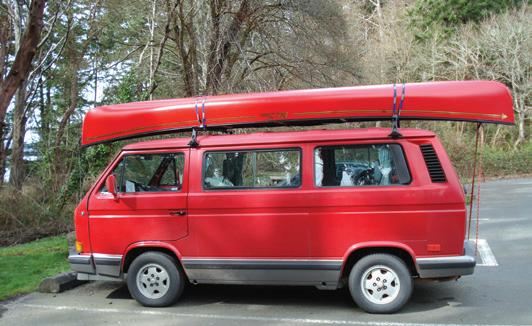

Another vision came after a long day beating down Saratoga Passage in our Kent Ranger 24 Bora on our way home to Tacoma after two weeks in the islands. Of course, it was in punky weather and, again, after a long period of discomfort; this time sitting in the cockpit dodging the powerboat wakes. We pulled through the breakwater and into the refuge of the marina in Edmonds, appreciating the calm water and tying up. Our first objective was hot showers in the excellent facilities there and, walking the docks on our way back to Bora, we passed a small boat with a couple sitting in the dinette drinking wine and playing cards. It was the first time I noticed the practicality of the C-Dory cruiser, and that image stayed with me for the next several years.
At that time, we also owned a VW Vanagon camper that we loved taking out winter camping to places like Space 47 at Point Hudson RV Park (right on top of the marina breakwater), or down to Astoria, or any of the ocean beach camping areas normally crowded to capacity in the warm dry months. We could sit at our own little dinette inside watching the pouring rain with wine and cards of our own. We really liked the idea of the same thing only on the water, not to mention navigating from inside the pilothouse.
Nonetheless, we kept sailing and loving it. As our son Brandon grew into his 6-foot teenage size, the little 24-foot Bora kept getting smaller and smaller, so we moved up to our Cal 27 Moondance. That kept the comfort level reasonable and Moondance was a pleasure to sail. Still, I often found myself sitting at the helm in the rain, bundled up against the weather and dreaming of a dry cockpit. I frequently saw C-Dory boats and that dock vision from Edmonds always resurfaced with bright clarity.
Brandon outgrew sailing with Tekla and me and, when he flew from the nest, the boat became a slightly wistful and quiet place. We sailed a lot those next few years, sometimes using Moondance as a weekend getaway just to relax in the slip during the cold winter months. In time, we began feeling a little unsettled with sailing. Of course, we still loved being out on the water, but we had been everywhere within weekend distance a dozen times, plus I was becoming less enthusiastic about rigging work and hauling out again to paint the bottom. Maybe it was time to shift…
I took some nice pictures of Moondance and put out an exploratory ad and boom she was gone. You know that adage, “The two happiest days of boat ownership are the day you buy the boat and the day you sell the boat.” Not true! We both cried when we went to the docks to take all our stuff off for the new owner. What had I done? We were now boatless.
To be honest, I had been looking at small powerboats when I decided to see if Moondance would sell, but I had not found anything that seemed right or reasonably affordable. Now, I felt panicked.
In the nine months that followed, we went to look at Bayliner Trophys and Cieras, Arima Sea Rangers, a SeaSport 24, and a few others. Every C-Dory that came up was either too new and expensive or sold the same day it came onto Craigslist. I missed out three separate times because I was the second or third one to call. Then one Thursday, I was doom-scrolling the boat pages and there was Sea Lab. This listing had the make spelled “Sea Dory” so it did not come up under a search for C-Dory, and thus it was still available when I called the seller in Oregon.
Kim, the owner, told me he had several inquiries in the first hours, but each had some amount of delay. I told him I could be there the next day, and he agreed to at least not sell to someone else until I had been there to look. I called Tekla at work to see if she could get Friday off and then went to the bank and took out a cashier’s check for the asking price, just in case it was the one.
That night I couldn’t sleep and lay awake wondering if I was acting rashly. I could not conclude that I wasn’t. It was 325 miles from our home to Roseburg, so we got up early and hit the road, hoping we had everything we needed to maybe pull the boat home. Kim called us twice while we were driving to make sure we were still coming, as he had a lot of response to his ad the previous evening. We finally arrived after what seemed like a terribly long drive and he met us in the driveway of his sprawling place and walked us down to the shed where the boat was. We were both pretty sure she was the one at first sight. Clean, stored inside, and not used for storage of junk overflowing from the house or garage.
We looked top to bottom and asked endless questions, and

When the author's son was young, the 24-foot boat seemed just right, but as he grew, the boat grew smaller.

Moving from the Kent Ranger 24 to the Cal 27 provided a more rewarding sailing experience.
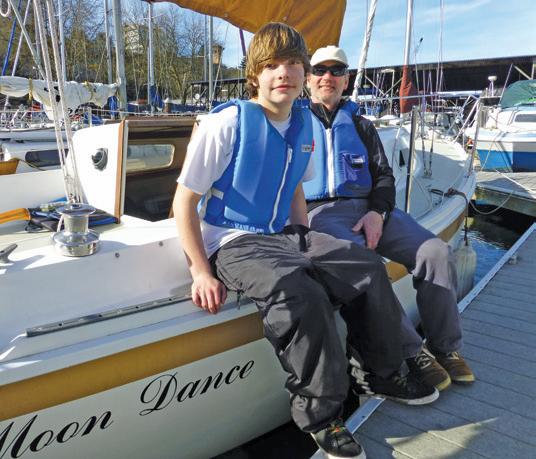
The Cal 27 increased the comfort quotient as their son grew to 6 feet tall.
Still smiling, but dreaming of a drier cockpit.


When smiles in inclement weather are harder to come by, it might be time to change gears (or boats).
eventually made our full price offer. He accepted. Suddenly, we were the proud owners of our very own C-Dory. It turns out that Kim’s wife didn’t really like being out on the ocean—they had only taken the boat out at Bandon on the Oregon coast a few times and it was too rough for her. He had bought Sea Lab from an estate not realizing the cult-like following of C-Dory’s, and so was not too attached to the boat. We got lucky.
Tek and I loaded all the stuff that comes with an older boat and politely declined Kim’s generous offer to stay the night, which I’m sure would have been fun and interesting. We hitched up the trailer, nervously uncertain as to whether our little Tacoma truck could pull such a boat, and hit the road. By the time we got to Cottage Grove, Oregon, the lack of sleep and the exciting day caught up with us and we decided we better stop for the night. I don’t always sleep well in motels, but I did that night and, in the morning, we were excited to coffee-up and get Sea Lab home. The drive was just as long back as it was down there, and we were pleasantly surprised at how well our little truck did over the mountain passes with such a heavy load. We were also surprised at how much gas it took to pull her over those passes, but that is just part of the deal.
We made it with no problems and backed Sea Lab into our driveway. After unhitching, we went to our favorite brew pub to celebrate with dinner and an IPA. The next weeks were spent getting to know Sea Lab sitting on her trailer and figuring out what to do next, since neither of us had any experience with powerboats, but already the learning had been exciting and fun. We started to think about the range of new possibilities this shift would bring.

The fulfillment of a dream many years in the making: cozied up dockside in the comfort of a C-Dory pilothouse.
Since that day, we have both learned what seems like an entirely new (to us) way to enjoy our time on the water. We certainly miss some of the special times that are unique to sailing, but I enjoy the anticipation of something new with the promise of self-discovery even more. We’ve loved beginning some of our cruises beyond our homeport by trailering Sea Lab to unfamiliar boat launches and exploring more and farther than before. It’s the next phase of our boating experience, and it continues to offer new rewards and, indeed, comforts.
Maybe, when some of that prolonged discomfort returns, there will be yet another gear shift, or boat, in our future.
Dennis, Tekla, and Tim Tim the sailor dog recently changed their home cruising waters from Tacoma to Case Inlet.

















Photo by Dennis Pearce.






One of the amazing aspects of boats are the attributes that make a design timeless. New school or old, boats that are both fun to sail and well built will stand the test of time. Add in a family-and-friends approach to a racing program, and it’s a win all around for those who get to cash in on the thrills and spills. Such is life for the ownership group of John Hoag, Jack Killalea, JJ Hoag, Will Nelson, Tim Player, and Ric Peterson, and their beloved 1983 Hobie 33, TC . Purchased in 2022 and homeported at Shilshole Bay Marina in Seattle, TC has a distinguished pedigree and is a regular on race courses (and podiums) throughout the Salish Sea—TC was 4th in 48° North’s Top 25 for 2024. We’re thrilled that TC’s most frequent skipper, JJ Hoag, is sharing stories of her family’s history with Hobie 33s, her arc of getting to know and love TC, and giving us a glimpse into some exciting plans ahead for this rad sailor and her boat.
by JJ Hoag and 48° North Editors
The Hobie 33 was an iconic boat in the 1980s and 1990s, and as passionate Hobie Cat sailors, my dad, John Hoag, and his brother-in-law, Todd, were eager to buy one. They teamed up and purchased a boat that they named Wild Thing. They successfully campaigned the boat in Puget Sound, winning the Hobie 33 North Americans before selling it and continuing their adventures on other boats. Tragically, in 2014, Todd passed away unexpectedly. My dad lost not only his sailing partner, but his best friend. Todd was always a “funkle” to me—the fun uncle—introducing me to the joys of racing Hobie 16s and teaching me everything he knew about sailing.
Fast forward to 2021, and my dad and his longtime sailing friend, Ric Peterson (who previously owned the well-sailed Hobie 33 Masked Man), began looking for a new boat, and the Hobie 33 was at the top of the list. Even though the design wasn’t modern, it remained a fantastic racing vessel and a more affordable alternative to newer designs. I think, too, that they wanted to relive the glory days of the 1990s.
We found the perfect boat in California, and for my dad, purchasing his second Hobie 33 thirty years after the first one brought back many cherished memories of Todd. To honor the legacy of one of the great Hobie sailors, a wonderful friend

The boat's namesake, Todd Christensen, unfortunately passed away in 2014.
Kept in dry storage at Shilshole Bay Marina, TC can be in the water and ready to sail in one hour.

and mentor, and the best uncle, we named the boat TC for Todd Christiansen. I know he’d be incredibly proud of what we’ve done with the boat and the amazing impact it’s had on young sailors in the Pacific Northwest.
HAVE YOU OWNED OTHER BOATS BEFORE THIS ONE?
I’ve never owned other boats, but my parents raised me on their race boats from the time I was a baby. We often joke that our family is always buying and selling boats. My dad has this incredible knack for seeing a boat’s potential, putting in the time and energy to make it faster and better, winning races, and then selling it, only to start the process all over again. He taught me the value of investing time in your boat, taking pride in the work, and reaping the rewards. It’s all about maintaining your boat and being proud of its condition. The one boat he hasn’t sold is his 1D35, Shrek, which remains his perfect vessel for Pacific Northwest buoy racing. Over the years, he’s built an amazing community of crew members who love sailing Shrek, making it a boat that will always have a place in our family.
The Hobie 33 was designed by Hobart “Hobie” Alter and Phil Edwards in the early 1980s as a racer-cruiser that blends elements of surfboards and catamarans. Hobie aimed to create a fast, lightweight, and easy-to-handle boat for sailors in the middle-income bracket, offering a balance of performance and comfort for both racing and cruising. The design was built by Hobie Cat in the United States from 1982 until 1987, with 187 hulls completed.
According to the original Hobie 33 owners manual, the key design aspects of the boat were:
• Performance: The Hobie 33 is built for speed, whether offshore or across the bay. It features a long waterline, narrow 8-foot beam, lightweight construction (4,000 lbs), a 1,800lb lead bulb keel with a 5-ft draft, and an inboard-mounted airfoil-shaped rudder. The unique “Motor Well” allows for an outboard engine that can be taken out and plugged for

reduced drag when racing. It was “all the newest technology” of the time.
• Trailerability: The retractable keel and 8-ft beam make it road legal, and the deck-stepped mast can be dropped by one or two people.
• Quality Construction: The hull is made from foam sandwiched between fiberglass, ensuring strength and stiffness without excessive weight. There’s a famous video of a Hobie 33 being purposely run aground and dropped from a crane to showcase its durability. Remarkably, that boat is still racing today.
• Class Racing: Designed to create a large one-design class, the Hobie 33 quickly gained popularity, hosting national events across the country, many of which my dad and Todd attended. Today, many have been modified outside of the class rules.
• Transpac: Hobie Alter specifically designed the boat with the Transpac race in mind, including the outboard well. He was committed to a boat that sailed well on the ocean.
• Visual Appeal: The sleek hull and tapered windows give the Hobie 33 its signature fast look.The original Hobie manual has some great quotes such as, “Not only does she look like a rocket at dockside, she behaves like one out on the water.”
Though “The Hobie 33 was crafted to provide both thrilling performance and reliable cruising,” the boat has built its following more for racing ability than cruising comforts. The whopping 4-foot standing head room down below makes it difficult to do really anything, but that’s not why you buy a Hobie 33. It’s cool history for a boat that probably exceeded even Hobie Alter’s dreams and remains an incredible budgetfriendly option for sailors who like to go fast.
We bought the boat, previously named Sizzle from Bill Hardesty in San Diego—a talented tactician and helmsman with 12 world championships and a Rolex Sailor of the Year award. Bill had big plans for the boat, including doing the Puerto
Vallarta Race and the 2020 Pacific Cup. He put significant effort into preparing it for offshore sailing, overhauling the instruments and rigging, and perfecting the bottom. In the 2020 Puerto Vallarta Race, he and his crew won first overall and North Sails published an article about their win and the boat. However, their plans for the Pacific Cup were derailed by COVID, and Bill decided to sell.
My dad and Ric Peterson drove down to San Diego in early 2022 and were impressed with the boat’s condition and all the work Bill had done. They were able to make a deal and purchase the boat, and then drove it up to Seattle. That spring, we began cleaning the Hobie up, starting new projects, and getting it ready to be back on the water.
WHAT DO YOU LIKE BEST ABOUT YOUR BOAT?
I was trying to put it politely, but plainly, “It’s because it’s f***ing fast downwind.” Unlike other boats of similar size, which might top out at around 10 knots while surfing, this boat is a skinny Ultra Light Displacement Boat (ULDB) and can hop up on a plane, reaching speeds of 18+ knots. We’ve had some thrilling sleigh rides with our masthead asymmetrical 2.5 kite, and the boat feels like a rocket while we’re just holding on for dear life.
It’s also so light and narrow that we sail it almost like a dinghy, roll tacking in light air, and fine-tuning weight placement for precise balance—a great opportunity for those of us with dinghy backgrounds to apply our knowledge and broaden our horizons. It’s a versatile boat, and it continues to surprise us with how it shines even in conditions that aren’t considered its “strength.”
WHAT DO YOU KNOW NOW ABOUT YOUR BOAT THAT YOU WISH YOU’D KNOWN WHEN YOU BOUGHT IT. WOULD THAT HAVE CHANGED YOUR MIND?
I’ve learned that the Hobie 33 isn’t an upwind weapon. Its lightweight design and lack of a deep rudder/keel make it harder to point as high as newer boats of similar size. This wouldn’t change my opinion of the boat, but it did take our team a while and some frustration on the upwind legs, to figure out how to improve its upwind performance. It taught me that even with the newest sails and the best crew on board, there’s a

critical learning period when you get a new boat.
WHAT’S YOUR FAVORITE STORY INVOLVING YOUR BOAT?
My favorite moment was our first time getting up on plane going downwind at Round the County in 2023. We debated whether to put the kite up in 30 knots, and I’m sure glad we did. The starting area was crowded with 100 other boats, but once we got some clean air, we could literally feel the boat lift out of the water, with the bow wake flying over the sides and the call for “Weight back!” At times it felt like riding a bucking bronco, but I was smiling ear to ear, watching the boat’s speed climb with every puff. The pure adrenaline and excitement was overwhelming, knowing this is what the boat was famous for— and boy, did it deliver.
Unfortunately, we were going so fast that the leg lasted less than an hour before we had to douse the kite and switch to a reach. But I loved when people on the dock came up and said, “Here comes this little Hobie flying through the fleet. We blinked, and you were gone!” The boat was surprisingly stable under the A2.5, and it didn’t take long to find the groove where she was happy in those conditions.
I’ll admit, during my first Race Week with TC, I felt incredibly defeated because we just couldn’t point upwind like our competitors. We were often nearing the windward mark almost last, only to catch up on the downwind leg, but then lose ground on every tack. I remember people on the dock reassuring me, saying things like, “Hobie 33s are difficult boats” or “Hobie 33s don’t point,” and it was a challenging time for me and tough for my team. We had this exciting new (to us) fast boat, but no one enjoys losing—especially not me. I had the age-old debate in my head: “Is it me or the boat?” Turns out, it was both. For me, it was about patience, learning from the wise sailors around us, not being afraid to fail, and having the courage to make changes and tweaks that would help us learn.
Now, three years later, I’ve developed a specific style for sailing this boat. I know which boats I don’t want to be to windward of at the start line. I purposely position myself in situations where I can foot off a little more to keep the boat
















happier and in clean air. Once the boat is up to speed, I can point and hold my lane, but it takes considerable effort from both the driver and crew.
A big part of our progress is thanks to my partner, Jack Killalea, who put together a spreadsheet and polar data from various Hobie 33s around the country and their ORC ratings. This has been huge for rig tune adjustments, ensuring our mast is set up for the correct wind speed and headsail. We’ve also dialed in our upwind angles in different wind conditions, so now we race the boat against itself, optimizing her maximum potential before comparing ourselves to the competition. We’ve gone from “just trying to sail fast” to having specific target measurements and goals that let us gauge how well we’re sailing. But, above all, it took time, patience, and a curious

by Jan Anderson.
within
(and
learning attitude. I know we’ll never fully “figure out” this boat because it continues to teach and sometimes frustrate me, but what an honor it is to have a platform with so much potential, one that will grow with us as we become better sailors.
We have big aspirations to do the Pacific Cup in 2026. Jack and I have always wanted to do more offshore sailing, specifically to Hawaii, and thanks to a lot of work put in by the previous owner, TC is already 90% of the way ready. The Hobie 33 was designed for Hawaii races, so it feels fitting to let it stretch its legs across the ocean. It’s exciting to know that even though this might not be the comfiest ride to Hawaii, it will certainly be a fast one.




This boat makes the author grin, and rightly so. Photo by Dennis Pearce. A girl and her go-fast boat, winning the Ballard Cup championship belt.

IF YOU COULD HAVE ANY OTHER BOAT, WHAT WOULD IT BE AND WHY?
TC is a special boat for where we are on our sailing journey. It’s not the most comfortable (not even close), fastest, flashiest, or most modern boat on Puget Sound, but it has a certain magic. It has a knack for creeping along in light air when all the other boats come to a stop, and despite the criticism it gets for not pointing well in big breeze, we’ve gotten it to perform exceptionally well in those conditions. We were the first boat overall in the PHRF class in the 2024 Possession Point Race, where we saw wind speeds over 35 knots, as well as 3rd overall and 1st in class in the recent Winter Vashon race with wind speeds in the mid 20s.
It’s hard to think of a better boat to be on when we’re going downwind in 25 knots, and thanks to its ULDB design, the loads are relatively light on the boat. Of course, there are other boats we sometimes envy on the race course. It would be nice to load up the weather rail with 1,200 pounds of water ballast like the Riptide 30 and 35 do when going to weather. There have also been plenty of times we’ve struggled to hold our lane against boats like the Pyramid 30, Scheme, or the Olson 29, Sabotage boats that point higher and have that extra upwind gear that the Hobie doesn’t quite have. But despite all that, there’s just something about the Hobie 33 that makes it so rewarding to sail.
When everything is tuned right, the boat just goes like nothing else. It’s hard to imagine a better boat for mid-distance racing around Puget Sound, for us anyway.
WHAT DIDN’T WE ASK YOU ABOUT YOUR BOAT THAT YOU WISH WE HAD?
Yes, “Who sails on your boat and why so many owners?” Sailing has always been a family affair for me, and with TC we technically have five different owners involved with the boat. I feel so thankful that we have an amazing team who sees the value in investing in the boat and all pitch in to make it easier and more fun for everyone. My parents taught me that it takes a village to own and sail a boat, and I am fortunate to have such an incredible village of people around to sail and race with.
I have to thank Ric Peterson and my dad who originally bought the boat and poured so much time and effort into it, giving my friends and me the opportunity to eventually buy it

from them. I also want to thank Dean Christensen, Todd’s dad, for letting us park the boat in his driveway to work on all our never-ending projects. He’s always our biggest supporter and tracks us on AIS during every race. Tim Player and Will Nelson have been longtime friends that have helped put hours into figuring out this silly boat and always making it a competitive but fun environment. And of course my partner, Jack Killalea, for managing the 15 different lines that come into the pit and keeping us competitive all the time.
While I’ve answered a lot of these questions from my perspective and experience with TC, I think everyone reading this knows it’s never just me on board. We would be nowhere without my team—too many of them to name!
If you’d like to share the story of your boat in a MY BOAT column, we’d love to hear from you. Please email 48° North Editor Andy Cross to get started (andy@48north.com).











The AquaDrive system solves a problem nearly a century old; the fact that marine engines are installed on soft engine mounts and attached almost rigidly to the propeller shaft.
The very logic of AquaDrive is inescapable. An engine that is vibrating on soft mounts needs total freedom of movement from its propshaft if noise and vibration are not to be transmitted to the hull. The AquaDrive provides just this freedom of movement. Tests proved that the AquaDrive with its softer engine mountings can reduce vibration by 95% and structure borne noise by 50% or more. For information, call Drivelines NW today.



by Joe Cline
Heady boat nerds will be familiar with the philosophical paradox known as “The Ship of Theseus.”
Originally recorded by the Greek Philosopher, Plutarch, this famous thought experiment poses the question of whether something remains what it is even after all of its original components have been replaced. For those who understand boats, wooden boats especially, it’s never very far from reality. Any wooden boat with a long life will have every plank, frame, knee, and breasthook replaced, even its keel will eventually need to be renewed. The fact that I personally come down on the side



that views the mythical Theseus’s ship as itself even after a complete replacement is moot in this article, however. This story starts with a different, though not unrelated question: What of those discarded materials that were formerly part of the ship?
If this isn’t the coolest example of what might be done with discarded material, I don’t know what is. Let me set the hook—a new boat is born, constructed of old-growth wood milled from the massive log of Western Red Cedar that was harvested near Washington’s Hoh Rainforest and spent the last 115 years as the main mast for the storied Schooner Martha. The new boat was built by maritime students spanning generations and backgrounds, different groups and

programs were hands-on at every stage of construction. This immense piece of timber spent nearly half of its history as a mast on a boat being used primarily for sail training; it facilitated countless hours of tangible maritime training in its next employment as building material; and now it sails again as a part of the fleet of the non-profit committed to education, adventure, and connection to the sea. This tree is a teacher.
A few years ago, the Schooner Martha Foundation set out to repair a substantial check in the vessel’s main mast. Assessing its condition, the foundation altered course and approached Northwest Maritime’s (NWM) Boat Shop Manager, Joel Arrington, about using the Port Townsend campus’s Boat Shop space

to construct a replacement. Arrington recalls, “Working non-profit to non-profit, I said I’ll donate the space but told them there was a condition—you have that 80foot stick of Western Red Cedar, it’s got a cool story, I’d love to build a boat out of it.”
Arrington’s inspiration began with the wood itself. He reached out to a dendrologist at the University of Washington, who helped fill in some details. Based on information about the majority of the logging at the time Martha was constructed and the locations of secondary growth forests, in addition to some specifics about where the yard that built the schooner sourced their materials, it is clear that the tree would have come from the area around the Olympic Peninsula’s Hoh Rainforest. The tree was likely harvested around the turn of the century, then it was barged down to San Francisco where Schooner Martha was launched in 1906.
Arrington had never milled a piece of lumber like this before. “It’s not often you get an 80-foot log of old growth Western Red Cedar. The fun part is that I had this enamored idea that it would be this beautiful old growth log that was so perfect, like what everybody thinks of being cut down 130 years ago. It was straight, but not especially high quality— it was super knotty and had some old checks and repairs.”
A graduate of the Northwest School of Wooden Boatbuilding, Arrington clarified, “Red Cedar is not considered a spar-worthy material—nobody would build a spar out of it now except maybe for a little dinghy or something—and the boat sailed for 115 years under that mast with no major issues.” As other sailors in the area can certainly attest with multiple Transpac races and an array of other intensive ways Martha is used, Arrington summed it up, “They sail the piss out of that boat, and it held up.”
Part of the vision for this former mast was an opportunity to host a 10-day strip building construction workshop for adult students—strip building is a technique for which Western Red Cedar is an ideal material. He guided students through how to develop and build a strongback, layout all the frames, and plank the boat with strips of the century-old cedar.
The students helped with some of the milling as well, cutting the bead and cove joinery on each strip. While there is an exceptional amount of prep work, when it actually came time to plank the boat, the class completed that phase of the project in a single long day, showing the efficiency of this type of construction. It took another six days to fair and sand the boat, add the skeg shoe and outer stem, and laminate the exterior of the hull in fiberglass, remove the boat from the molds and repeat the process on the interior before building out floor timbers, thwarts, seats, and the gunwale assembly. By the end of the class, they had built a boat that was structurally sound enough to go into the water, and the new boat had a “soft” launch and test run of rowing around the harbor at the Wooden Boat Festival in 2022.
The design of the boat is an adaptation of the Sid Skiff, drawn by Ray Speck of San Francisco. Speck is a legend in the West Coast wooden boat community, and has built Sid Skiffs in production. Speck donated the plans to NWM for this project. Of the Sid Skiff, Arrington said, “They’re traditionally built clinker, and one of the cool things about this boat is that it’s a more modernized construction, we shaved off probably around 200-pounds from the finished product.”
All up, the new boat weighs only about 95 pounds; and the clinker-built Sid Skiff that sits outside the Boat Shop window weighs 300 pounds and includes 1,400 fasteners. The new boat’s hull thickness with laminations is ⅜ of an inch, which would be at least a quarter-inch less material than a traditionally built version. With a number of modifications away from the original 13-foot Sid Skiff design, the NWM Boat Shop crew began calling the boat the “Grizzly Skiff” through the build process as a way to delineate its differences from the original design (after being thrilled with an extensive sponsorship that included $50,000 in new tools to outfit the shop from the Bellingham-based power tool manufacturer, details in sidebar). The Grizzly Skiff is now called Ruby, named after the Olympic Peninsula’s Ruby Beach near the origin of the fabled tree.
The modifications from the original extend beyond construction. The Grizzly

Milling a portion of the Western Red Cedar mast with Maritime Career Immersion students.

Strip building workshop students work to affix the thin cedar planks they helped mill.

There was a lot of prep work before and finish work after, but the Grizzly Skiff was planked up in a single long day.
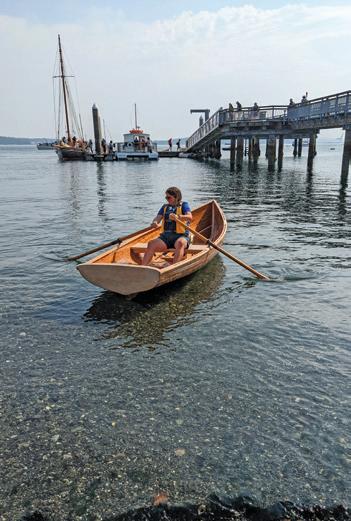

Skiff switched from the Sid Skiff ’s traditional centerboard to a daggerboard, for simplicity and better sailing performance. It’s a true foil and was calculated and cut on the CNC by Brandon at Port Townsend’s Turn Point Design. The entire fit-out, thwarts, sheets, internal structures, rudder, daggerboard were all made of off-cuts from the remarkably high-quality aircraft grade Sitka Spruce harvested on Vancouver Island and chosen for Schooner Martha’s new mast (which interestingly utilizes elliptical box construction for extraordinary stiffness).
The lumber for Ruby’s loose-footed sprit rig also came from Martha’s mast, but incidentally it’s not Western Red Cedar. Martha was originally gaff rigged, but in the 1970s it was refitted with a Marconi rig, at which time 27 feet were added to the mast. This additional length was Alaskan Yellow Cedar, clothes-pinned on to the top of the solid Western Red Cedar mast. So, Ruby’s sprit and the mast are made from that Alaskan Yellow Cedar that was on the top of Martha’s retired mast for last 50 years.
gold leaf detailing and boat lettering found on Ruby’s hull and transom— notably, this student apprentice has since moved onto further study at Port Townsend Maritime Academy.
It’s clear that one of the values of Arrington’s deep knowledge is his ability to be creative with curriculum, helping students build useful maritime skills by adapting to the present needs of whatever project is underway at the time. Students cycling through the NWM programs had their hands on the Grizzly Skiff in each phase of the build. MCI students got a particularly great exercise in boat joinery when they built out the sole boards. “How do you make things fit into something that’s not square and build strength in the boat?” They learned to make tab patterns, build the daggerboard compartment, and develop the basics of marine finish. Arrington noted, “A student off-ramping into work at a boatyard will have a taste of those skill sets now.”
At the time of this writing, the Northwest School of Wooden Boatbuilding is teaching a week-long sailmaking class, and the end product will be a beautiful, custom built new sail for this boat. Like almost all boat builds, the Grizzly Skiff has been a shared passion project that has brought more people together than anyone might have guessed. And they’re better for it.
The original strip planking workship dovetailed into numerous follow-on educational opportunities in NWM’s Boat Shop, not to mention layers upon layers of community engagement. Arrington estimates there were at least 100 hours of work required to complete the boat after it was built, and he’s paid to facilitate learning, not build boats himself. Volunteers were involved. High school students were involved. Nick Mann of Whalesong Signs worked with an apprentice from NWM’s High School Maritime Career Immersement (MCI) program to teach the lovely traditional
With its elegant lines and light weight, the boat rows incredibly well. And its sailing performance has also impressed everyone who has caught a little wind in Ruby’s loose-footed sprit sail, with the exquisitely honed deep daggerboard delivering grins at almost any angle of heel.





Looking back on the project, Arrington is satisfied with so many aspects. He didn’t use the word, but I think he’s proud as well. He mentioned several times how important it felt to him to “take a traditional model and utilize contemporary techniques.” He says of this approach, “It’s a good way to instill more transferable skills—we love to celebrate old wooden boats, but teaching contemporary techniques is more transferable to a career path.”
But what’s most special about this project is all of its unique local connections. Western Red Cedar trees have been known to live at least 1,500 years. And while this tree’s exact age is not known, it was of our region, and had an actual life that makes Schooner Martha’s extensive history seem fairly brief. Once harvested and employed as a main mast, it enabled innumerable adventures and was the centerpiece of the sailing rig that started and trained many, many stalwarts in the PNW maritime scene, from lifelong enthusiasts to industry professionals. And in this project alone, countless community ties were made or
strengthened between those of varying skills, backgrounds, and aspirations in the world of boats.
For Arrington, it circles back to what respect—even love—for the timber can teach maritime students. “It’s good practice in recycling materials. We don’t have a lot of these old growth trees left, and the modern techniques are a better use of the old chunks because they have less waste than the traditional.”
This fine tree will now live on as Ruby the Grizzly Skiff and, with its place at Northwest Maritime, it is inevitable that this Olympic Peninsula Western Red Cedar will continue its generous teaching tradition—as a mast on a sail training schooner and as material for betterment and skill building of maritime students— by showing the next generation what some awesome ancient wood can do on the water.
Joe Cline has been the Managing Editor of 48° North since 2014. Thanks to the many photographers whose images appear in this story, including Joel Arrington, Sam Trocano, as well as those named and the author.





When Bellingham's Grizzly Industrial Tools sponsored the Northwest Maritime Boat Shop with a donation of $50,000 worth of new tools—from huge band-saws to hand-held power tools and a stateof-the-art air filtration system—no one knew exactly what the impact would be. Everyone just knew it was big. A year into the relationship, Boat Shop Manager Joel Arrington says one major benefit is the ingenuity and flexibility enabled by a complete set of reliable, predictable, equallyfunctional tools. "The Grizzly tools make more projects like the Grizzly Skiff possible," Arrington enthused.



Evergreen-studded islands, abundant wildlife and peaceful anchorages. Experienced or new to boating, we can help you discover the joys of cruising the beautiful San Juan Islands! Beginner to advanced liveaboard courses. Sailboat and powerboat bareboat charters. Guided otillas too!



by Sheridan Ferguson
Editor’s Note: To read a more detailed account from the author’s perspective, and to more fully acknowledge all those who responded throughout the crew overboard situation that took place on March 8, 2025, during the Possession Point Race, please find an extended version of this article at 48north.com.
Well, I broke the first rule of sailboat racing. I got home from the airport Friday night excited for a day of racing on Saturday. I spent the night the same way I always do before a race—no alcohol, lots of water, and my bag packed and ready by the door. I knew my ratty, ancient, and trustworthy lifejacket was in the car. I had been checking the weather all week, and the HRRR model now predicted 15 knots out of the south in the morning, calming down to 10-12 after the start of the race. This was going to be my first race on my skipper’s new boat. She’s an absolute dream of a vessel, and I could not have been more excited.
The morning progressed just as expected, loading the boat and running lines. As soon as we left the breakwater, I remember noting that it was quite a bit more wavy than I anticipated, but that’s not out of the norm. My lifejacket went on not long after, and Brent Campbell and I started going over this new-to-us bow, familiarizing ourselves with everything we could. By the time the main went up, it was already blowing a little more than the prediction. We noted 18 knots as we went back and forth near the start. I went downstairs right before the start to put on one more set of socks so my feet wouldn’t get too cold… little did I know. When I came back up, my skipper asked if I was ready to go really fast. Heck yeah I was.
We got off the start line in a bit of a rush. With 3 minutes to go, Brent and I were hurriedly running tapes and rigging up the A2 spinnaker on deck. By the time we were satisfied and turned around to ask when we were starting, someone helpfully said “Now!” The kite wasn’t banded, so with me on the bow helping the tack out, Brent hauled it up with gusto. It popped beautifully, the jib came down, and we were off.
The speed is hard to describe. The boat didn’t even feel like she was trying, and all of a sudden we were doing 13 knots consistently, popping up to 16 on the right waves. All of us were calling out new top speeds as we saw them. Before long, the staysail was called for, and Brent and I went to the bow to get it up. This only made the boat feel more under control and capable, and our top speeds continued to climb. So did the wind. By now, we were looking at high teens, with the occasional 2022 knot gusts. The staysail needs to be furled before each jibe, so every time we got the “ready about” call, I would pop forward and pull like heck on the furling line, and then jump back to help the kite around. We ended up on our last long jibe aiming for the Edmonds ferry dock, all of us astounded with how fast

we’d made it up the Sound already. We had one more jibe, and then the staysail would come down, the jib would go up, the kite would come down, and we’d begin what I imagined would be an incredibly quick upwind and, ideally, win the race. If only...
Before the last jibe, Brent and I had noted that the wind wasn’t going down. It was now sustained in the low 20s, with 3-4 foot tightly packed waves, and every gust launched us to yet another top speed. I saw 21.4 at one point, and my excitement, nerves, and heart rate all jumped at the same time. All I needed to do was help the boat through a few more maneuvers, and the rest of the day would be just as fun, but much calmer. The jibe went as smoothly as any of us could have hoped, and the boat went barreling down her layline toward the mark. Not long after, the staysail was furled, and Brent and I made the astute decision to throw it down the forward hatch, no organization, sheets and all. Brent grabbed the halyard and reminded me to dog the hatch when I was done. “Well, no duh,” I thought. We’d already seen green water over the bow.
At this point, I was in a place that only bow people understand—waiting for the call to get the jib up and the kite down, hoping they would give me lots of time. It was confirmed we were on our last jibe, and I brought the lazy spin sheet around
the bow and over the boom for a letterbox drop. The kite wasn’t going back up, so it felt like the safe and prudent option. The call came moments later, and up to the bow I went. Brent set himself up at the mast to raise the jib as soon as I had it clear. I scrambled over to the sail tie holding the jib and cleared it. Just as I looked forward to help feed the jib up (and maybe grab on to something more stable) the world turned upside down.
I watched the first bit of the wave come over the bow and thought, “Gosh darn it, I’m about to get soaked.” But the water that hit me was so much more than a bucket to the face. Instead, I was instantly underwater. I felt myself sliding along the deck, cursing that I hadn’t grabbed onto something sooner. I thought I’d hit a stanchion any second, or the mast, or Brent, or a shroud… It wasn’t meant to be.
I later learned that the jib had gone over with the same wash of water, and removed everything in its path, snapping half the bow pulpit and two of the stanchions on the starboard side clean off. The next thing I knew, I was in open water. My first thought was, “Shoot, there goes my stellar track record of never falling off a boat.” My arms and legs were free, by some miracle, and I realized instantly there was officially nothing I could do to help my crew. I was now a problem for them, a man overboard. I had no control of anything other than keeping myself alive, and that

was the best thing I could do for them. It’s amazing how fast your mind works in these situations. I’ve been asked how long I was underwater, and I can’t even begin to guess. It might have been 10 seconds, a minute, a year, who knows. Logically, I’d say about 30-45 seconds from sitting on the bow to popping up in the waves. But my gosh did I think about a lot in that moment. I thought about the last hugs that I’d given my friends and family. I thought about everything I should have said to my husband that morning beyond the paltry, “I love you, hope you have a nice relaxing day.” I thought about my dad, still on deck, and what he would go through when he saw me in the water (one way or another). I thought about my crew and the fact that now more than ever, my life was in their hands. Mostly I decided that I really wanted to live.

































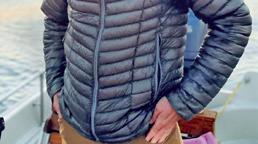

The water was rushing around me like nothing I’ve ever felt, so opening my eyes never crossed my mind, but I knew picking a direction to try and swim was the wrong answer. I had no idea which way was up, but my lifejacket would get me there eventually. I felt around with my hands as best I could, and remember feeling boat, boat, boat, not air, just boat. I was afraid I would hit the keel or rudders or lines or sails and get hung up. I was terrified of getting stuck. It would have been so easy, but I didn’t. After my eternity underwater, all of a sudden there was air. Not enough

































































































































































































































































































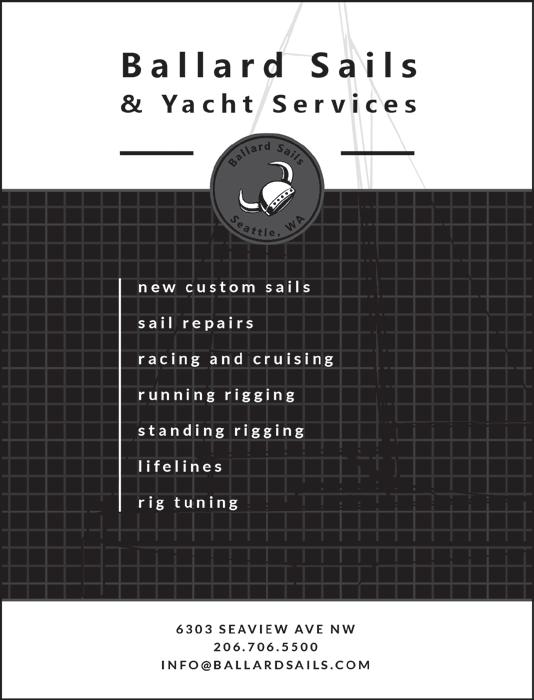


air, but air. Filling my lungs seemed like an absolutely impossible task, but I sure got to trying.
The first thing I saw was the boat heeling at an unfortunate angle, and blowing away faster than I could ever hope to swim. I tried for a few seconds and quickly realized it was never going to happen, I would never make it. Then I saw the jib in the water, coming up from underneath on the port side. That wasn’t right. On deck, I saw our pit person, frantically working to get everything under control, our tactician frantically pointing at me, and then my dad. He had both hands on the lifelines and what I will tritely describe as a look of pure and absolute terror. But he saw me, he knew I was ok… ish. It was then that I looked around in the water and realized I wasn’t alone. Brent had catapulted from his position at the mast moments after I was swept away, also bound for an under-the-boat swim. He had already grabbed the MOM (man overboard module) that our skipper had launched, and swam to me while I tried to swim to him. In a blessedly short amount of time, we were together. We watched as the boat continued to drift away, thinking surely they’ll get everything under control in no time and come back for us. Right? Well, not exactly.
The Martin Breaker on the kite tack had broken free when the boat tried to become a submarine. It was flying remarkably clear but, no easy feat, the crew aboard got it down in no time. We knew it would take them time to get the lines clear of the water and to get the jib back aboard before turning the engine on and putting it in gear. Wrapping a prop in that moment would have been disastrous. According to those crew members who did not break Rule #1 of sailing, the jib got wrapped around the keel, and proved nearly impossible to bring aboard, even in pieces.
Brent and I could only watch and speculate as the boat got smaller, and the Sound began to feel so much bigger. We could see other boats on the course, but none came close enough to even try to yell for them. We watched the Farr 39ML Absolutely take her sails down, and prayed that she was coming to find us, not just calling it for the day. She was coming to find us, but had no idea where to begin. Even with the yellow, 6-foot-tall inflatable MOM mast above us, we were invisible.
The conversations you have as two people who have just escaped death once but are very aware you’ll need to do it again are wild. Not spectacular or that abnormal for your average dinner party, but hearing about how someone met their spouse in that circumstance hits in a completely different way. Brent and I first established that personal bubbles weren’t a thing, and latched together. Losing each other would have been even more of a nightmare. The MOM unit provided extra floatation, for which I was incredibly grateful. I hadn’t tightened my lifejacket to ‘slightly uncomfortable’ that morning—a mistake I will never make again—and staying above the waves was a beast. Had my wits been about me, this should have been the moment I pulled the whistle out of my lifejacket pocket, where it lives tied for moments exactly like this, but I completely forgot about it.
After some long minutes, Brent asked if I was sure we were the only two in the water. I wasn’t, of course, we hadn’t been able to see the whole crew on deck in those moments. What a terrible feeling that was. He also commented that he was so glad he had put his lifejacket on that morning—he was the last one
aboard to do so. Wear your lifejacket, people. In between dinner party small talk, horrific situational discoveries, and monstrous waves, I informed poor Brent over and over that my toes were still wiggling, I couldn’t breathe, and I was very, very cold. If there was ever a time for dramatics, this was it. Oh, and I must have kicked him in the shins approximately 4,000 times. What a man overboard partner!
I was getting cold. The adrenaline and shock must have helped, but good heavens, that water was f***ing cold. I estimated low 50s when we were in it, but learned later that Puget Sound was at a whopping 47 degrees. At some point early on, I had grabbed the neck of my foulie jacket to close it as tightly as I could, and keep in as much slightly-warmer water as possible. In reality the cold didn’t matter—nothing could be done about it, and staying above the waves felt so much more important. Soon, I was just too tired, and needed my second arm to stay afloat, so each wave washed a whole new level of cold down my neck.
Finally, there were boats coming towards us. I know now that they weren’t looking for us specifically, we were just incredibly lucky that we went overboard on the layline. By later estimated observations, we had drifted approximately a third of a mile from the last known location provided to the Coast Guard. I remember seeing three race boats coming straight at us, and the hope began to build. There was no moment of “We’re saved!” at least for me, just a gradual build of hope.
The Aerodyne 43 Freya’s jib came down, more hope. When Freya turned around to come back to us, even more hope. I owe Freya all the thanks for indicating to the rest of the fleet where we were, but unfortunately they weren’t able to grab us. They had gotten their jib down, but not their main, and they couldn’t slow down enough to help us out of the water. They threw a LifeSling, but as I watched it go skipping across the waves right next to us, I knew trying to grab it was a bad idea. They tried for a second pass, but they were just going too fast.
Next came the J/111 Lodos. I’m grateful to everyone involved in our rescue, but to the crew of Lodos: three cheers, hip-hip hooray, and a round on me. They had followed right behind Freya and took down all sails in case they could help. This is also about the time I looked up to see the bow of the EdmondsKingston ferry, Suquamish, standing-by upwind to provide a wind shadow to aid the rescue. While logically I knew they were there to help me, looking at the length of a ferry from the water was frightening!
Lodos began her first circle with the LifeSling, and I desperately tried to keep my head up. By now, my not-tight-enough lifejacket had worked itself up my torso, and swimming was getting ever harder. But we managed to grab that LifeSling line, and what a magical feeling it was. The crew of Lodos did their best to follow the LifeSling instructions, and told us to wait until the sling got to us before pulling us in. By the time the sling reached us, it was simply moving too fast for me. I don’t know exactly how Brent fared in that moment, but I was immediately back underwater and desperately gasping for air. Pretty quickly, I had to let go. I held onto the MOM unit, and Brent let go of the LifeSling and swam back to me as soon as he noticed I was gone. I may have been a liability for him, but he wasn’t going to let me be alone out there, for which I am endlessly grateful.
We reconvened, and Lodos came back for a second pass. This time, when we grabbed the line and were told to wait for the sling to reach us, we said “NO, PULL!” and bless them, they did. We were about 30 feet from the transom at the time. I will forever hold the image in my mind of JJ, one of my many new favorite people, pulling us closer and closer in her bright green jacket. When we were about 10 feet off, I watched the transom fly up in the air and slam down in the waves, and thought, “How silly to die being squished by a boat after surviving this water for so long.” Luckily, everything was actually very ok. Before I knew it, we reached the transom, I put my arms up in the air, and all of a sudden two people had me. They had me! I was completely useless in helping to get myself on board, but it didn’t matter. They pulled, and I flopped euphorically on that deck like a dead fish. I felt Brent come up right behind me, and in the blink of an eye, we were safe. Words cannot describe.
Alas, the story does not end here. I tried to get my arms underneath me to lift my head off the deck and quickly realized I had turned into a jellyfish. My muscles were completely useless—they had done everything they could when it mattered, and they were done. I was plopped in JJ’s lap and held her hand as tightly as I was able. And I breathed. I vaguely remember talking a lot, mostly to prove to everyone that I was not in fact a dead fish, and to express how very excited I was to be out of the water. Some moments later, we were bumbled down below to start removing many waterlogged (and frigid) layers. Brent appeared to be in better shape than I was, and JJ helped me out of my lifejacket, foulies, vests, fleeces, etc. She lent me a dry







fleece, hat, and one of the famous Shrek jackets, talking to me the whole time. I had an inkling that we knew each other. Our parents later confirmed that we’d been fast friends as kids on a Norpac cruise 20 years ago, staying up late together to watch the stars. It’s beautiful how this world turns around and brings people back together.
By now the Kitsap County Sheriff ’s vessel had pulled up alongside, which had a heater on board! Back up on deck we went. I crumpled on the rail, feeling again quite helpless, and looked to the man who appeared ready to catch me. I said something very helpful like, “I can’t.” He was perfectly calm when he said, “Ma’am, this is why I work out. I can lift you with one arm.” Next thing I know I’m levitating off the deck and was on the floor of the Sheriff ’s boat. I crawled from there to the floor inside as fast as I was able, and flopped again. My god did it feel good. Brent followed, I assume with a bit more self-control. I had given up helping myself and turned into a doll to be helped by others. This is unlike me, and normally I would be entirely averse to it, but I was too grateful to be alive. I was informed we were bound for the hospital, which I accepted immediately. The shivers were starting to kick in with a vengeance. Someone gave me a big hug to hold me in my seat and help me start the warming process, and Brent threw an arm around me from behind. If I had the energy, I would have been sobbing with gratitude. They asked me questions: Did you hit your head? Are you sure you didn’t hit your head? Followed by more questions to prove that I did not, in fact, hit my head.
In what felt like five minutes, we were pulling into the Edmonds


fuel dock. Now I was shivering for real; not a great feeling, but everyone was very excited about it. “She’s shivering, she’s shivering a lot!” as though I was solving some incredible math problem and they were watching in awe. “Yay for me?” I thought. Having learned a bit about being very cold recently, shivering marks the transition from moderate to mild hypothermia, and is actually quite a success if I do say so myself.
In came the EMTs, yet more angels on earth to be grateful for. A very nice EMT came up and informed me she was going to take all my wet clothes off, and any sense of dignity I had held onto quickly departed. She made impressively quick work of it. I had no idea how many people were going to see my, um, girls, going into the day. In no time flat, I was as vulnerable as one can be, wrapped up in at least four blankets, still shivering.
The next adventure—my first ride in a fire truck! They put stickers and wires all over the place for what I assumed was an EKG; and tried to take my temperature, but kept saying “weird” which I did not find comforting. They also tried to place an IV, unsuccessfully, in multiple places. Every time I blinked I was getting stabbed somewhere else, but every blood vessel I have apparently said “no.”
During this trip I got a hold of my thoughts enough to realize I needed to call my dad, now. I still wasn’t entirely sure Brent and I were the only two people overboard, and I could only imagine what hell my crew was going through not knowing where we were or how we were doing. A kind man lent me his phone, and I was miraculously able to remember my dad’s cell number. What a relief it was to hear him say, “This is Dave?” and get to say, “It’s me!” I gave him the quickest download and let him know we were headed to Swedish Edmonds.
We pulled into the ER, and I was bundled off to yet another group of incredible lifesaving people. A whole new round of stickers was placed for what I knew to be an EKG this time, and a successful heated IV, as well as more difficulty getting my temperature. After various attempts… 94 degrees. Hallelujah. I knew I was on the right track when the last nurse walked out of the room telling me to hit the call button if I needed anything. I realized immediately that I hadn’t been alone since the drive to the boat that morning. It was a less-than-welcome feeling and everything started to crash down at once—the near death experience, the many minutes of fear, the complete lack of control. Then the EMT whose phone I’d borrowed popped his head in to let me know that Dad would be there within 20 minutes. I thanked him profusely, for the information and for saving me from the crushing weight of my own thoughts. I stared in desperation at the clock on the wall until, sure enough, my dad’s smiling face appeared from behind the curtain to inform me that I’d broken Rule #1 of sailboat racing (like I didn’t know).
Dad and I had just begun to trade the stories of the day when my darling husband joined us. We got to chat with my very freaked-out mother too. Luckily, my husband and mother didn’t know that anything had gone wrong until I was safe and warming. I can only imagine the panic that they would have endured if they’d heard before we were pulled from the water.
I’m the sort of person who says I love you in excess. Every time I leave the house to pop to the grocery store, every time someone heads off to work, every time a dear friend hangs up
the phone, “I love you.” In those moments under the boat when I wasn’t sure I was coming back up, I didn’t have to wonder about the last thing I’d said to my friends and family. I never really knew why I said I love you so much before, but I do now, and it will never change.
Within an hour or so, my temperature was back over 98. My doctor informed us that, by some miracle, all of my tests had come back perfectly. My heart, electrolytes, muscles, lungs, were all functioning just as intended. Brent was down the hall from me—we got to check in and make sure he was ok before leaving, I was not about to take anyone’s word on his well-being.
By the time we all piled into the car, sailor that I am, I was in desperate need of a beer. I mean, if ever a day deserved it. We made it to the marina about the time the boat was getting settled at the dock, and I got to give and receive many much needed hugs, get a beer in hand (along with lots of water, of course) and debrief with my crew. These people, who I trust with everything I have, held my life in their hands. And they knew it. The MOM unit was in the water before I’d taken my first breath above water, which kept us afloat and allowed us to be found. The Coast Guard was hailed within moments with the GPS coordinates that brought the Kitsap County Sheriff’s boat, half our fleet, and a freaking ferry to my position. Had no one found us, my boat would have been 5 minutes behind our rescue team to pick us up. Those would have been a long 5 minutes, but we would have made it, because I sail with the best crew on the Sound. If any of those things hadn’t happened, I would be dead. Let that be sobering and incredibly comforting in the same moment.
The gratitude that I have for the last few days cannot be contained in words. To everyone that has reached out to me, I love you. To my Mom, who let me swim in really cold water as a kid. To my crew, who followed protocol and made it possible for me to sail another day. To Absolutely, who pulled sail immediately because we mattered more than the race did. To the Coast Guard, who managed VHF communications with my skipper, and sent a helicopter out to (fortunately only) watch over the rescue. To Freya, for finding us. To Lodos for getting us out of the water. To the Kitsap County Sheriff’s Department for truly astonishing boat, situation, and people handling. To the ferry Suquamish and an entire boatful of passengers including Troy Hutt, who recorded the rescue from the ferry, providing an invaluable resource for LifeSling and man overboard recovery training. To every other boat that came for us. To my wonderful, beat-up lifejacket that got me safely underneath a race boat moving at unimaginable speeds, above water, and stable for 45 minutes in a situation that I should not have survived. And to Brent Campbell. As I said in the water so many times, “I’m so sorry you’re here too, but I’m so glad I’m not alone.”
I will sail again. I’ll start small, curled up around a pushpit in (hopefully) 5 knots of breeze, and I’ll work from there. I have absolutely no regrets, with one exception… I wish I had tightened my lifejacket that morning. Thank you to everyone, everything, and every god. I love you all.
Sheridan Ferguson lives aboard with her husband and two boat cats on Lake Union in Seattle. She's been racing and cruising Puget Sound from an early age.


MAY 24 – 25, 202
swiftsure.org #swiftsure







• Swiftsure Lightship Classic, PHRF NW
• Cape Flattery, PHRF NW & ORC
• Juan de Fuca, Monohull & Multihull, PHRF NW
• Inshore Course, PHRF BC
In honor of the 80th running of the Swiftsure Lightship Classic, The Skippers Meeting and 2024 Prize Giving will be held at the Royal Victoria Yacht Club, 3475 Ripon Road, Victoria, B.C., 2:00–5:00 pm, Friday May 23, 2025.
REGISTRATION OPENS
Monday, February 3 rd 2025 at swiftsure.org/ registration






by

by Stephanie Campbell
Ithink we’ve all heard the saying, “We put it up and God takes it down!”
During the 2025 edition of the Anacortes Yacht Club Girts Rekevics Memorial Foulweather Race on February 22, there was plenty of that. God might just decide to rip it in half in the process. It was a sporty year, but it isn’t called the Foulweather Race for no reason; and happily the breeze was going the right direction. There was a healthy registration list, and nearly all of the boats made it out to the starting line despite the big wind forecast.
On my Santa Cruz 27, Wild Rumpus, we reefed while we were still inside the marina and never shook it out. On the opposite extreme, we were the only insane people who hoisted the spinnaker at the start. And we didn’t need divine
intervention to make our kite decisions, we put that thing up and down ourselves many times before our early arrival in Friday Harbor.
As usual, all boats started together in Fidalgo Bay on the third Saturday in February. Winter winds are usually from the south, and this year was no exception. It was decisively a run for most of the race, and definitely at the start. Being somewhat sane, we started on the starboard jibe. Others in the fleet shared our strategy, and it was a tad crowded a few minutes into the race. Eventually someone was going to spook the herd and we would all have to jibe for Guemes Channel, with a handful of boats sailing wing-on-wing and lasting a bit longer on starboard. There were a few threats in the area and we decided to douse for the first time prior to our jibe. My son Dylan took his usual spot on the bow, this time

clipped in. Kite down, pole down, jib up, pack the kite, run the gear to the other side, kite up, repeat as needed!
Guemes Channel was a bit calmer and more and more kites went up. Neptune claimed a few of the colorful sails and one halyard, but on we went. Rosario Strait was actually fairly tame that morning, considering the breeze. And despite a couple close kite crossings, and some white knuckle driving (I mean, it is really early in the season) we made it to Thatcher Pass without too much drama. Steve Orsini on the Beneteau First 35 Black Arrow might have put some fear in my heart at one point, but they kept it rudder-side-down and the kite in one piece. Our heroes on the Baltic 39 Pangaea and Burns 49 Sir Isaac put up the big genoas and powered through without any of the kite nonsense that the rest of us insisted upon and kept up just
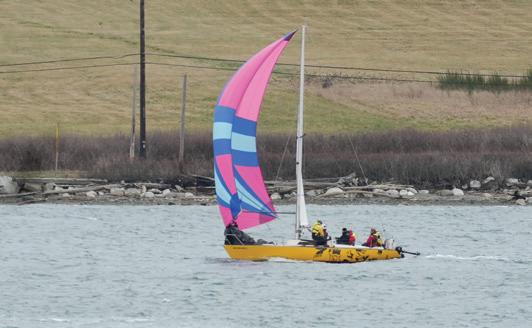
fine. The last brave boat to keep up the spinnaker was the crew on the Carrera 29 Loose Cannon skippered by Dagny Kruger. They would fly past, wipe out, recover and go again, with gusts well into the 35 knot range, and well past any thought that I had of hoisting. Neptune claimed both their kite and their halyard in the last big puff before the corner of the Lopez Island ferry landing, but they were still right there next to us for the rest of the race.
On Friday night before the race, I had been making noise about how your finish only counts if the kite is up for it. My son Dylan was fully on board with this and was pushing for a hoist to the finish in San Juan Channel. I probably should have listened, and maybe we would have made up the two minutes that we needed for the overall win. Nonetheless, I was pretty ok keeping the kite cozily tucked into its bag.
Though last year’s new course record still stands (Nige Oswald and crew, Gavin Brackett and Ryan Carson, completed the course on his F25C in less than 2 hours in 2024) it was almost certainly the fastest





Girts on record for the fleet as a whole. It would be hard to get there much faster without a much bigger boat or more hulls. Many boats finished the 18.5 mile course in about two-and-a-half hours and we all started piling into the Friday Harbor guest docks in short order.
Many thanks go out to the volunteers at the San Juan Island Yacht Club, who came in a few hours early to open the bar and feed us an early dinner with smiles, as always. The evening ended with a survivor party at the local bowling alley, and then a totally calm Sunday motor back home.
Congratulations go out to John and Ann Bailey on Sir Isaac, winning the Shorthanded Division and the race overall. Vince Townrow and crew won Division 1 with their J/105 Kinetic, and Wild Rumpus took Division 2. John Sanford also sailed shorthanded and won Division 3 with his Beneteau 265 Callientè. Congratulations to everyone who braved the appropriately foul weather, and had a fabulous time. See you next year!
Photos by Michael Beemer.







by Cindy Larrison
The Southern Sound Series closed out the winter racing season with a new host club and new course for its fourth and final installment in March. Corinthian Yacht Club of Tacoma (CYCT) is the new host for the Islands Race, and presented a new 35.2 mile course up East Passage to Blake Island and back down to Brown’s Point.
The variable late winter weather held true to form for this event. The forecast called for a good breeze around 15-17 knots with gusts to 30-ish, and rain was expected for most of the day. The starts unfolded with a rolling sequence of dark skies and choppy waves followed by sunshine and sometimes flatter seas, followed again by dark rainy skies, and then more sun. Foulies, reefs, and sunglasses were required all day long.
After a few last minute retirements (some following damage sustained during the extremely windy Center Sound race the week prior), 32 boats competed across seven classes in reverse start order.
The mid-morning starts went smoothly, and the steady breeze kept everybody moving smartly northward with boats starting to round the Blake Island mark before noon. Here’s a description of the racing from Mike Cain, one of the skippers of the J/105 Panic:


Starting downwind, Panic held starboard, then jibed at Dash Point to pick up the stronger breeze in the center heading up the course past Des Moines.
Boat speeds across the class early in the race were 10-12 knots with a following current and relatively flat water. The Antrims proved well-suited for these conditions; at the Three Tree Point buoy we could see them about a mile ahead. We dropped the kite at the buoy, rounded in the lull, exchanged pleasantries, and then got back on our horses.
With kites re-hoisted, the wind shifted left so we sailed a hotter course to lay Blake Island, making our way through the flats and spikes. One 25 knot gust kicked us up to 14.7 on the speedo—a new personal boatspeed record! As the wind bent farther left, the kite was going to become a problem, so down it came.
We rounded the leeward mark alone, the Antrims still with a fat mile on us. Bracing for the windy beat, we worked into a groove and kept Panic fast. Main trim in these conditions is hard work. Maintaining the 7.1 knot groove, we noted the Antrims seeking relief on the east side. Fortune smiled upon us as they crossed into a big right-hand shift. Our quarry at long last came within reach at the mid-channel mark as we passed Redline. Just north of Robinson, —gnarwahl was within reach about 1/8 mile ahead.
At this point, we opted to take a chance and go right. Why not? We had been working in a right shift; why wouldn’t that continue? Right it was. Headlong into the washing machine. Wind and waves, and at one point we saw 32 knots of wind. Not a fun slog, but once through, we again connected with —gnarwahl, though by then they had put it to us with breeze relief from Dash Point and they finished ahead of us by 8 minutes.
A second in class was a welcome reward for a challenging race. It had been a super fun day that had it all—a full range of conditions and great competitors!
The event used an “AIS On” requirement, which allowed the Race Committee to track the fleet on this unknown course. It also showed boats spreading out after rounding the mark and beginning the bash to weather in big breeze. This also enabled the committee’s chase boat to check on vessels showing unusual courses or retiring under concerning circumstances.
Riptide 35 Terramoto took both Line Honors and ORC class honors. Class honors went to the Moore 24 Bruzer who also won the PHRF overall, Beneteau 35 Bodacious, Antrim 27 —gnarlwhal, J/35 The Boss, and Olson 40 String Theory; as well as C&C 34 Jolly Rumbalow and CAL40 White Squall in the Commodore classes
CYCT would like to express appreciation to their “coaches” from South Sound Sailing Society, Tacoma Yacht Club, and Three Tree Point Yacht Club whose combined assistance was fantastic in getting started hosting such an important event for the racing community. And of course, thank you and congratulations to all participants!

1978 ISLANDER
Classic for sale by original owners. Rare mahogany interior, with new cushion in the v-berth. Repowered in 2010 with a Yanmar 30. Currently on land at Pacific Marine, in Anacortes. More info available
» Contact John Lane • Text: (207) 276-2403 • j3lane@aol.com • $24,500

1969 26' COLUMBIA MACH II SAILBOAT A CLASSIC!
It is time to sell our beloved family boat. Many upgrades over the years. Electronics: force 10 kerosene heater VHF radio. Sunbrella uphostery. Alchohol stove. Head with sink & holding tank. Upgraded rigging. Roller furler. Dinghy. Bruce Anchor. Spinnaker. Dodger with awning. Stern rail w/ built in ladder. 9.9 Mercury outboard. Price includes 1 month moorage. » Contact Robin McCain • burtonmccain@msn.com • $5,500
Aft cabin. Very good looking boat, good condition, professionally finished, Yanmar 2 cylinder 18hp, about 380 hours. Built with offshore travel in mind. Met the love of my life who didn’t share my vision. Many extras, including 7’7” achilles inflatable, Winslow 4 person life (needs recertification) Moniter windvane, much more.
» Contact Jim Herman • (253) 380-1413 • boatbutcher@hotmail.com • $59,000

30’ YANKEE ONE SLOOP SAILBOAT Master Mariner award winning, designed by William Starling Burgess/Stone built. Wooden hull. Roller furler. “Flame” totally restored in 2015. Complete survey in 2023 available. “A Sailor’s Sailboat”. Located in Richmond, CA. Classic wood racing sloop. » Contact Bob • stefroche916@gmail.com • $49,900 $49,900

This gorgeous Bermudian Double Ended Yawl was designed by Paul Gartside, built by Jespersen Boat Builders in B.C., Canada and launched in 2012. The Hull is Cold-Molded with Western Red Cedar, Douglas Fir, Fiberglass and West Systems Epoxy. The boat is beautiful, incredibly well-built and ready to sail for any horizon! View article: https://www.woodenboat.com/onlineexclusives/la-vie-en-rose » Contact (360) 316-9370 • Rob@PortTownsendBoatCo.com • $299,500 $299,500
$16,000

FOR SALE 1994 CATALINA 270
Perkins 18 HP Diesel, Pedestal Steering, 100 & 130 Jibs, tri sail, main, dodger, wheel and sail covers, and a wing keel. » Contact Mark • (206) 784-4474 • mjquam2@q.com • $16,000
$135,000

2003 JEANNEAU SUN ODYSSEY 40
Amazing performance cruiser for Salish Sea or offshore. Blue water vet: Mexico, Hawaii and Alaska. Excellent condition with all the gear: near new Yanmar 4JH57 (160 hrs) direct drive; aux fuel tank; MAX prop; watermaker; ESPAR hydronic heat; RADAR; AIS; power winch for main, Etc.. Does it all with ease: single handed, with crew or family. Contact for full listing info. » Contact Dave Stromquist • (360) 606-9043 • dstromquist@comcast.net • $135,000
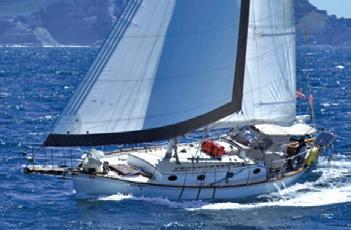
$79,900
Upgrades (2019 – 2022) include engine (Beta 43), Navionics Suite, Solar, standing / running rigging, roller furling genoa, main and staysail. Monitor self steering, new max prop 4 blade, new electrical switchboard and cabling throughout. Completed 12 month circumnavigation 2022-2023. Ready for more. Complete list of upgrades and recent surveys available. » Contact Douglas Wertz • (509) 438-1151 • dougwertz55@gmail.com • $79,900

This is a world capable yacht, ready to take you cruising. Beautiful yacht in really good condition. She is cutter rigged with oversized rigging and extra cockpit winches. Major equipment has been replaced or renewed. She is cruise equipped. Location is Orcas Island, WA. » Contact Tom Owens • (360) 632-8896 • svlandsend@yahoo.com • $110,000 (Private Sale)
$47,500

1975 WESTSAIL 32 FOR SALE
Chinook is very well equipped and professionally maintained. Comes with 6 sails, Profurl jib, 40 hp Kubota diesel, wind vane and autopilot steering, electric windlass, 4 anchors, 2 rodes, Furuno radar, 2 chartplotters, 2 depth sounders, VHF with DSC and AIS, fridge/freezer, diesel heater, compost toilet, solar panels, 80 gallons water, 75 gallons, fuel, dinghy and motor, winter cover. » Contact Fred Bray • (250) 755-6803 • fpbray2145@gmail.com • $47,500

Actively being sailed in Mexico with limited delivery avail. This is a ready-to-go legendary bluewater cruising boat! Meticulously updated. Major powertrain & engine room refit in 2023. Only 430 hrs on rebuilt Perkins 4.236! Rich varnished wood interior. Private owner’s cabin. Spares for every system. More details & photos: https://westsail42forsale.wixsite.com/hull1 » Contact Craig McMaster • (425) 736-8540 • westsail42forsale@gmail.com • $60,000 $60,000
$90,000

Excellent condition, well maintained, in-mast furling, Yanmar 39M30F diesel, new Hub Carbon batteries, 200W solar panel, full dodger, 8’ titan AL260 dinghy on davits, 8 HP 2-stroke Yamaha outboard engine, 200 ft chain and large Rocna anchor, windlass, fresh bottom paint, autostream 3-blade feathering propeller, massive lazarette, spacious and light interior, top down freezer and front-loaded fridge, interior and exterior showers, lots of storage space. » Contact Tony Boardman • (604) 720-8364 • anthony.boardman@sauder.ubc.ca
• $90,000
$13,950

WALKER BAY YACHT TENDER
Walker Bay Generation LTE 2019 11’ x 6’. Rarely used – Great condition. See in Anacortes, or Pt.Hadlock. Evinrude ETEC 30 HP outboard – Just fully serviced. Simrad chart plotter with depth sounder. Bilge pump, running lights. New, custom Sunbrella cover. Lifting eyes and strap down points. Custom lifting harness. » Contact Peter Brown • 1(206) 890-3325 • petermaldenbrown@gmail.com • $13,950 OBO
40’ – 48’ – 60’ slips. Great location in Poulsbo, WA Restrooms, Showers. Call the Marina Manager for availability and waitlist options: 360-779-7762










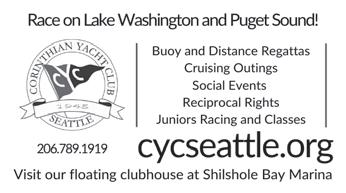


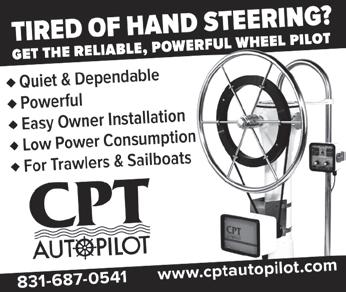




The US Coast Guard Auxiliary is preparing for 2025 beginners and advanced boat classes throughout the Pacific Northwest: Bellingham, Everett, Edmonds, Port Ludlow, Seattle, Gig Harbor, Tacoma and beyond. Your instructors are experienced boat and yacht owners, operators and cruisers. Sponsored by USCGAUX, D13, Flotilla 12, Edmonds. Instruction is free as a member of the USCG Auxiliary! Membership is subject to approval. cgaux.org » Contact Kevin Coulombe (Flotilla Staff Officer - Public Education) • (206) 245-8662 • cgaux130fl12@outlook.com • $35
For even more photos and listings check out 48north.com/classifieds








A Leader in Brokerage Sales on the West Coast (619) 224-2349 • Fax (619) 224-4692 • 2330 Shelter Island Dr. #207 San Diego, CA 92106 www.yachtfinders.biz • info@yachtfinders.biz

70’ SANTA CRUZ 70 ’87
$299,000
....................
“WESTERLY” Completely updated with no expense spared.An excellent opportunity to obtain a very up-to-date SC 70 and get sailing now.

49’ OCEAN CATAMARAN 49 ’00 $189,000 “LICKETY SPLIT” Fast-cruising catamaran recently updated with new sails and electronics. Needs finishing touches.
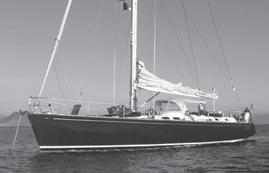

66’ GORBON 66 ’97
$550,000
....................
“BAJAVENTO” A luxurious performance vessel that can easily be sailed shorthanded. Professionally maintained. Cruise in style and comfort.
45’ BENETEAU OCEANIS 45 ’14
$285,000
....................
“ADELIE” Bright, airy interior with all the bells and whistles. Solar panels and upgraded electrical system. Three private staterooms.









36’ CATALINA 36 MK II ’95 $64,500 “COCKNEYREBELII”Perfect for coastal cruising and/or liveaboard. Constantly upgraded and meticulously maintained.

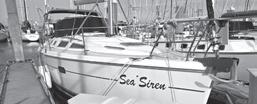
41’ SEN KOH KING’S LEGEND 41 ’82 $60,000 “THE HAMMER II” Well-built blue water performance cruiser with full inside helm station. Ideal for long-range cruising.
35’ HUNTER 356 ’02 $79,900 “SEA SIREN” She’s in excellent shape. Transferable slip in Monterey Municipal Marina is available upon the sale.

38’ CATALINA 380 ’97 $79,900 “FREUDIAN SLOOP” Well laid out, spaciously designed cruiser for daysailing, coastal cruising and living aboard.




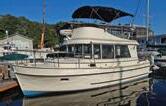


The Allures 39.9 is a rugged centerboard cruising yacht designed by Berret Racoupoeau. Allures’ unique design features a aluminum hull with composite deck – the best of both worlds in terms of strong and low maintenance construction. Her centerboard retracts fully into the hull, giving her draft of only 3’6” when raised (she may be beached if desired) and providing fantastic sailing performance off the wind. Her two-stateroom, two-head interior layout with “garage” technical room is optimized for long-distance cruising and has a bright and open feel while retaining design elements necessary for an ocean-going boat. Arronax is a well-equipped version and ready for extended cruising with a 400 watt solar array, wind generator, Webasto diesel heat, bow thruster, recent standing rigging, electric halyard winch, B&G electronics, radar and AIS, Hydrovane self steering system, watermaker, liferaft and EPIRB. This is a fantastic cruising package. She is Canadian-flagged and duty-paid.



